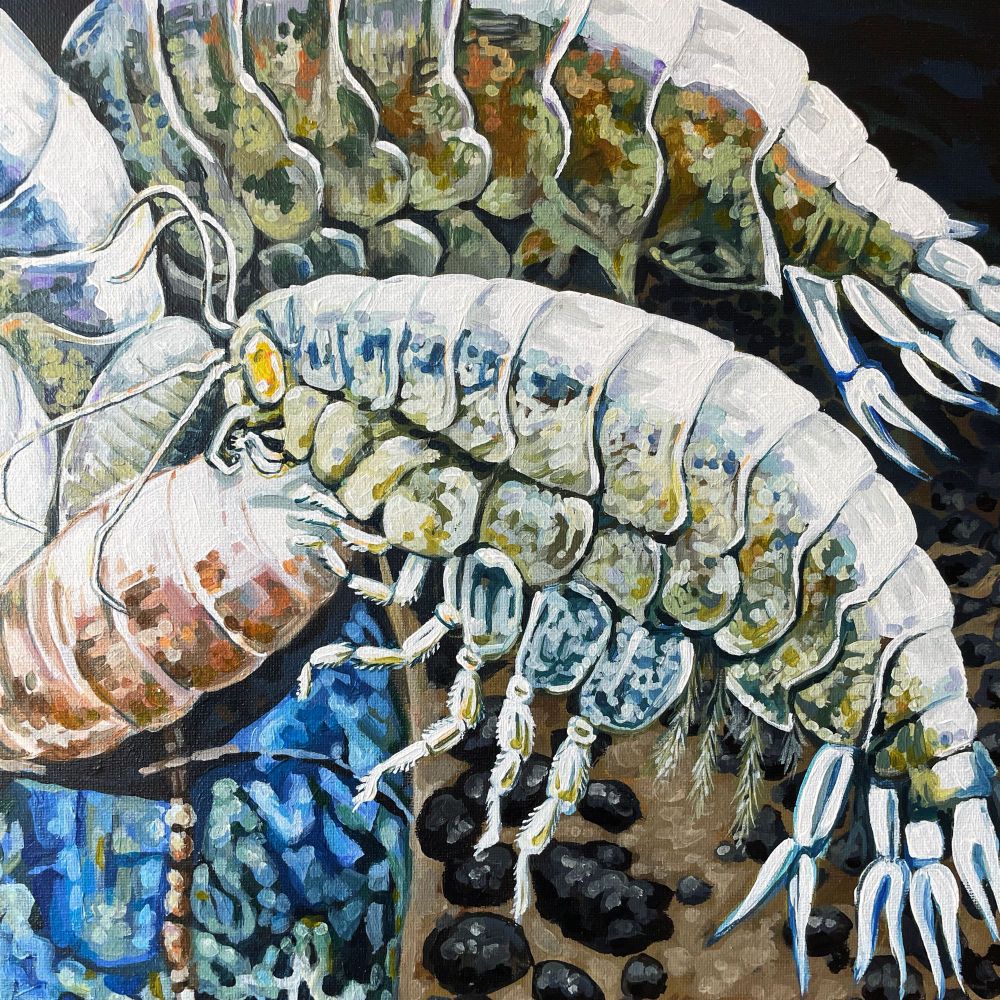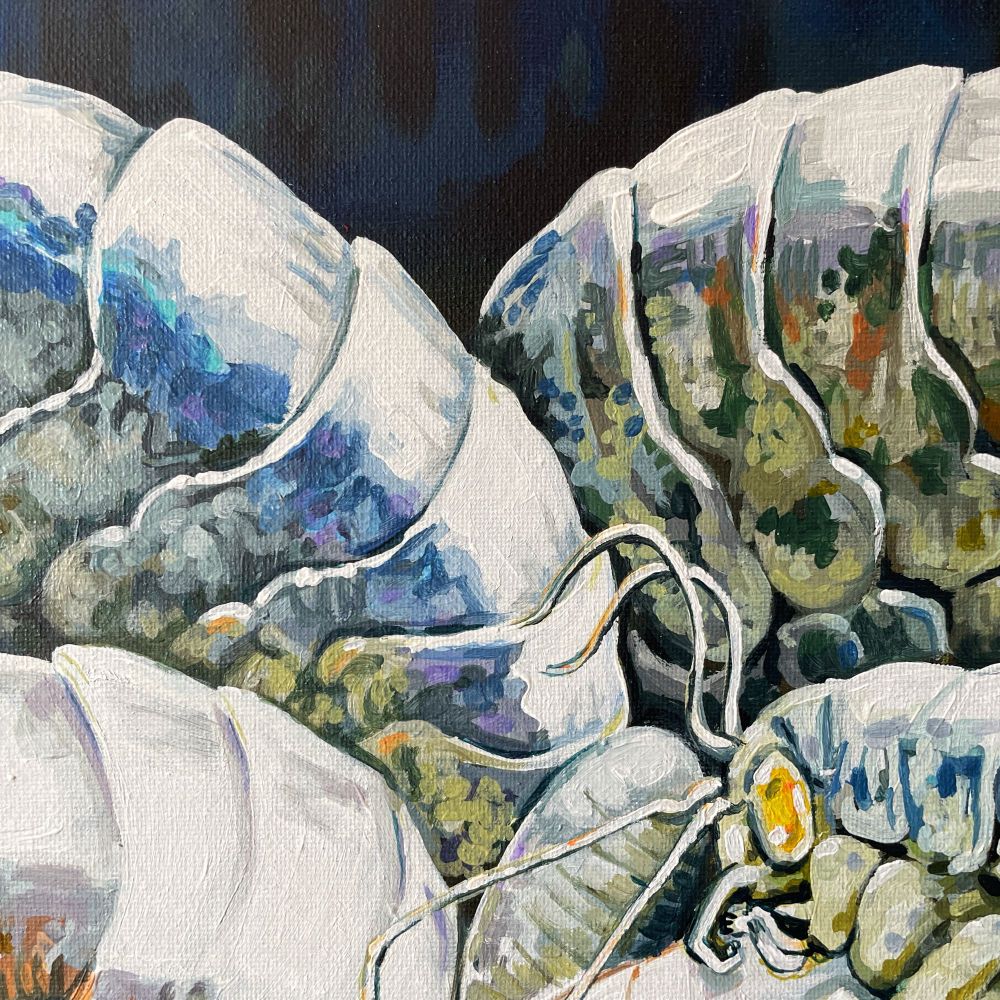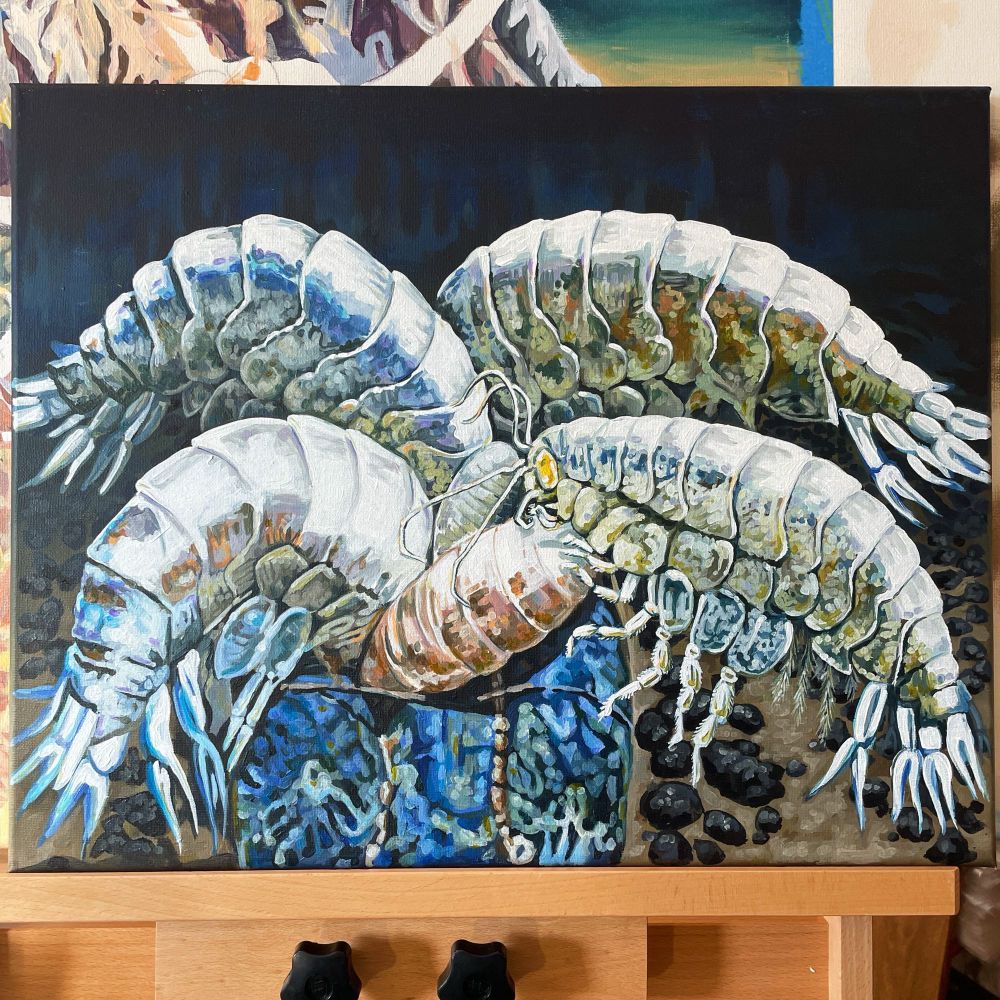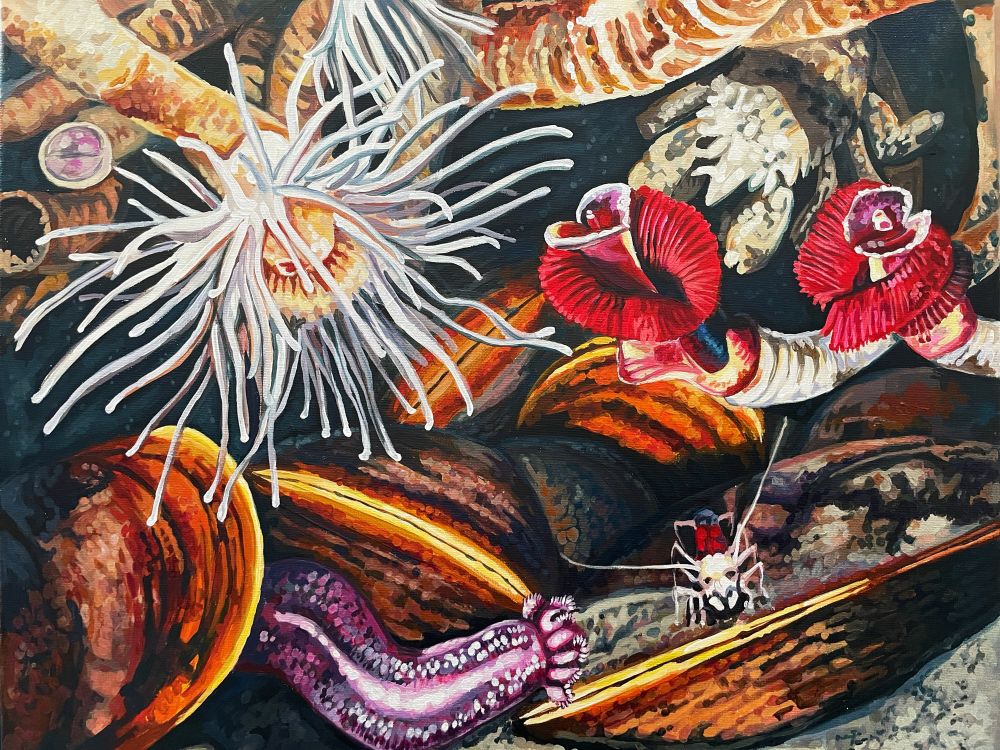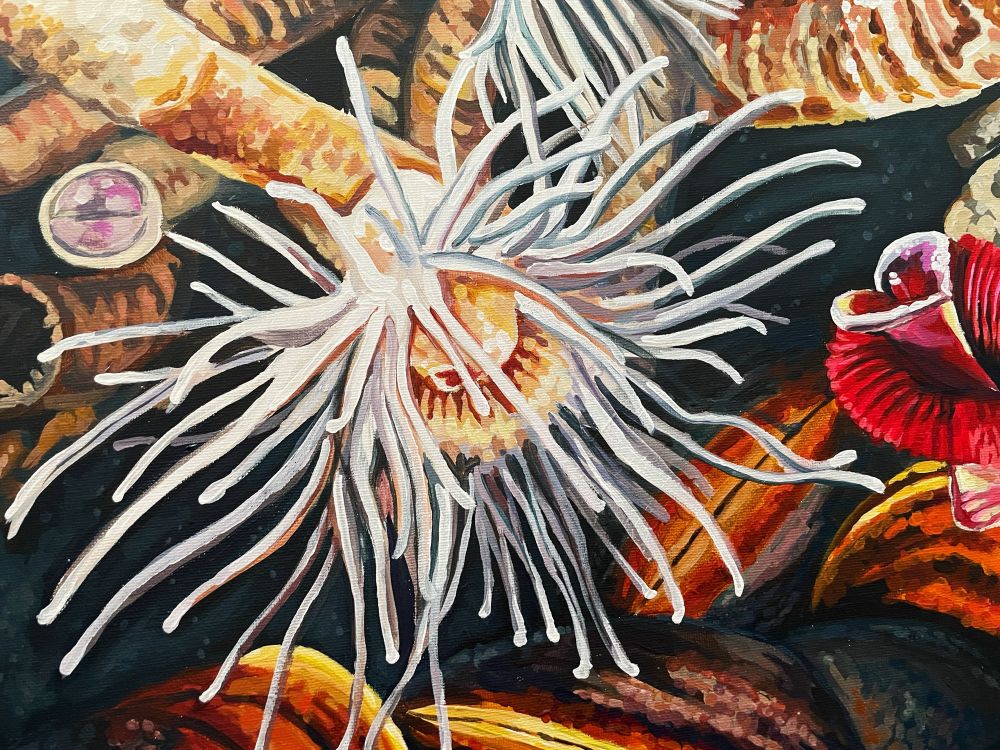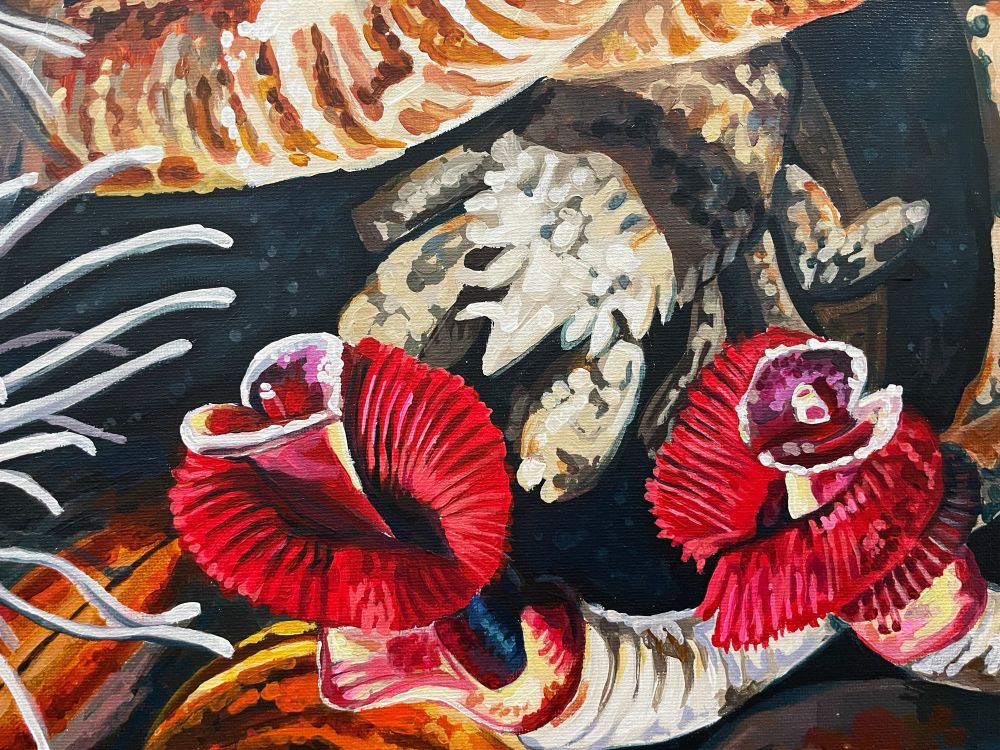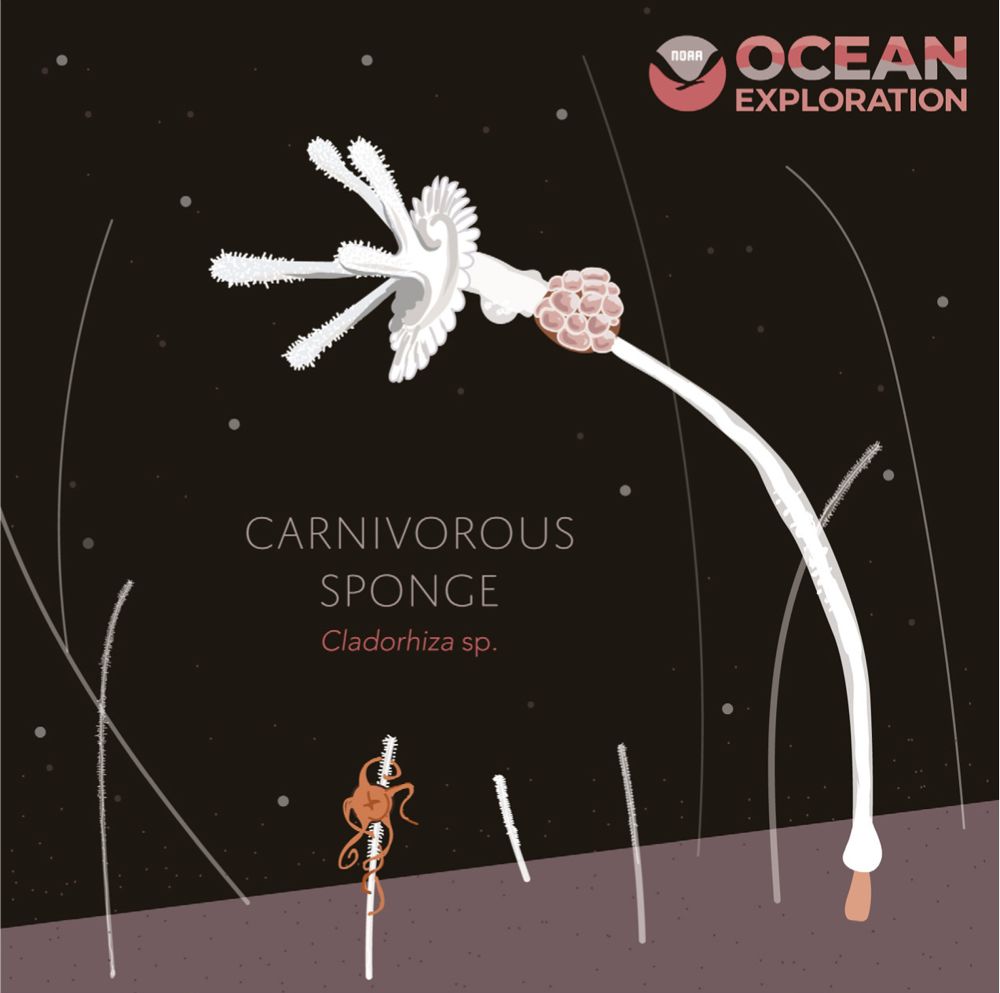
The Unseen Ocean Collective - Spokane Arts
The Unseen Ocean Collective receives support from the Spokane Arts Grant Awards (SAGA) in its second round of funding in 2025
Friends! I’m so excited to share that our Unseen Oceans collective just received a Spokane Arts grant to fund a 10 day art and science program in Spokane WA! You can read more here: spokanearts.org/grantees/the... @planulara.bsky.social 🐡🦑 #deepsea #deepseacreatures #deepocean #art
01.08.2025 17:12 — 👍 25 🔁 11 💬 1 📌 2
Do you want to collaborate across disciplines?
Hoping to create engaging outreach and interdisciplinary work that resonates far beyond science?
Join us: one month left to sign up for ArtSea Matchmaking!
#sciart #deepsea #marinebiology #dsbsoc #oceanart #scicomm #artseamatch
@dsbsoc.bsky.social
31.07.2025 16:52 — 👍 8 🔁 6 💬 0 📌 0
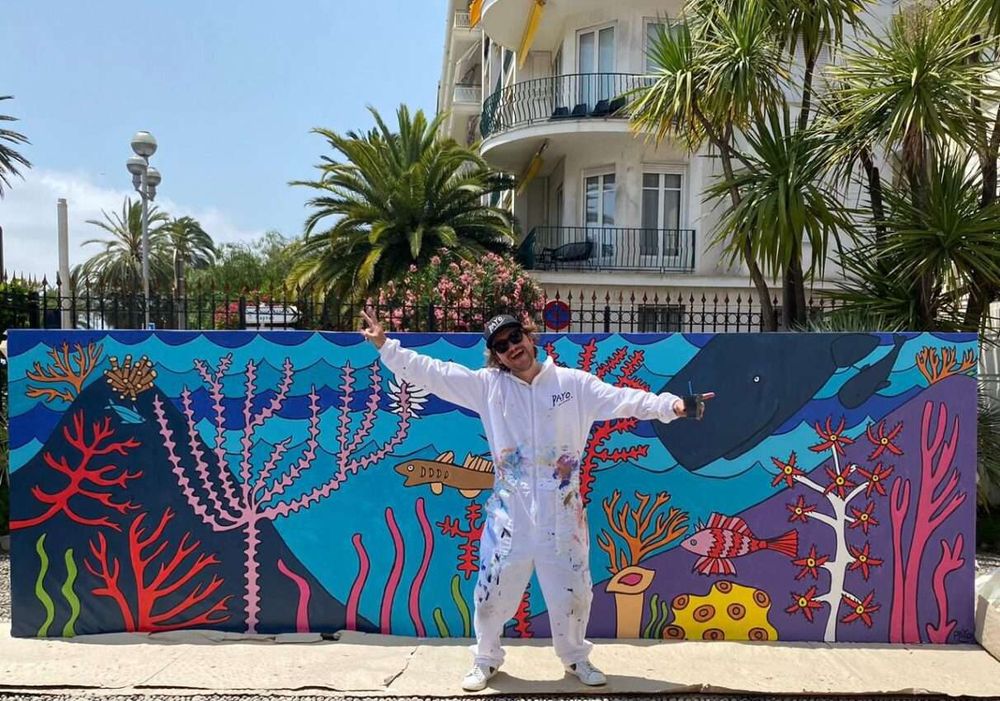
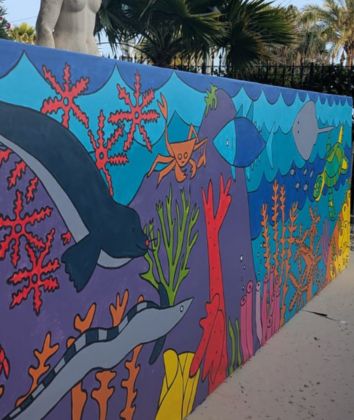
Bringing together deep-sea knowledge, art and public engagement, we’ve been working with Chilean artist #PayoSochting to create large-scale ‘Deep Dive’ murals, showcasing the natural wonders of seamounts across the world 🎨
24.06.2025 16:40 — 👍 8 🔁 2 💬 1 📌 0
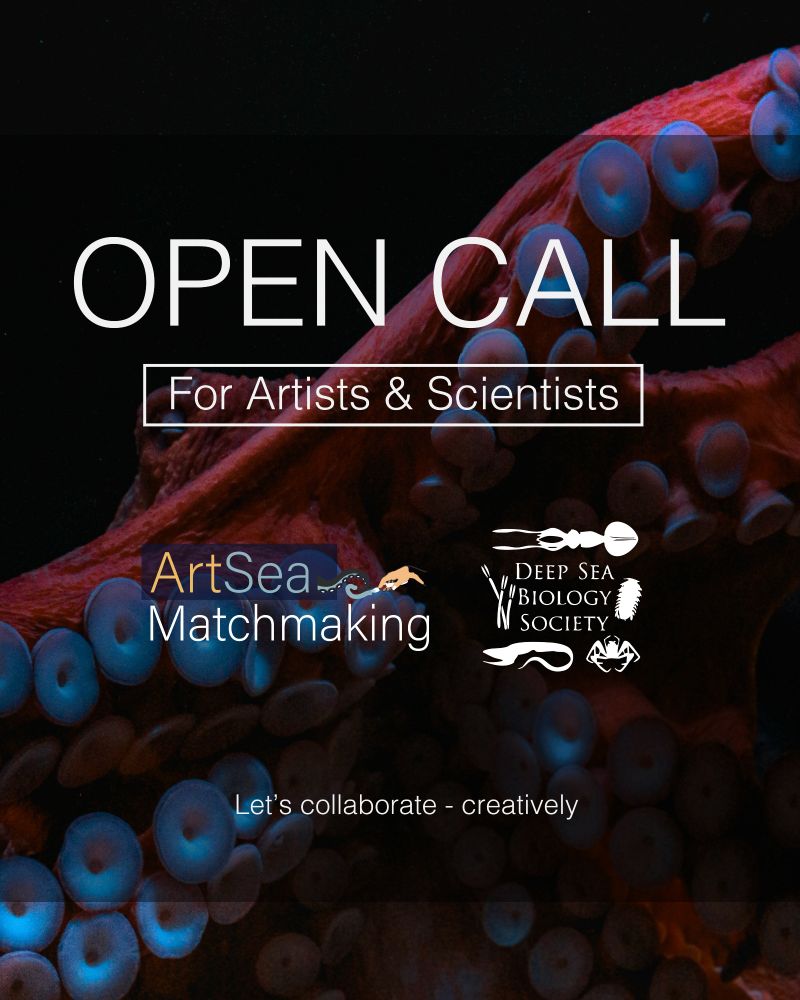
Are you inspired by the mysteries of the deep? We're launching a new initiative ArtSea Matchmaking that pairs artists and scientists for creative collaborations rooted in deep-sea science.
Together, you'll co-create compelling work that bridges disciplines and reaches wider audiences through exhibitions and outreach.

🎨🔬 CALLING ALL ARTISTS & DEEP-SEA SCIENTISTS!
💡 Open to ALL artists & scientists
🗓 Deadline: August 31
📍 Apply via the short form in our bio / link below!
🔗 forms.gle/SftLbez3ML2j...
25.06.2025 07:14 — 👍 45 🔁 31 💬 5 📌 8
Thank you so much! So glad you like it 😊
22.06.2025 16:50 — 👍 1 🔁 0 💬 0 📌 0
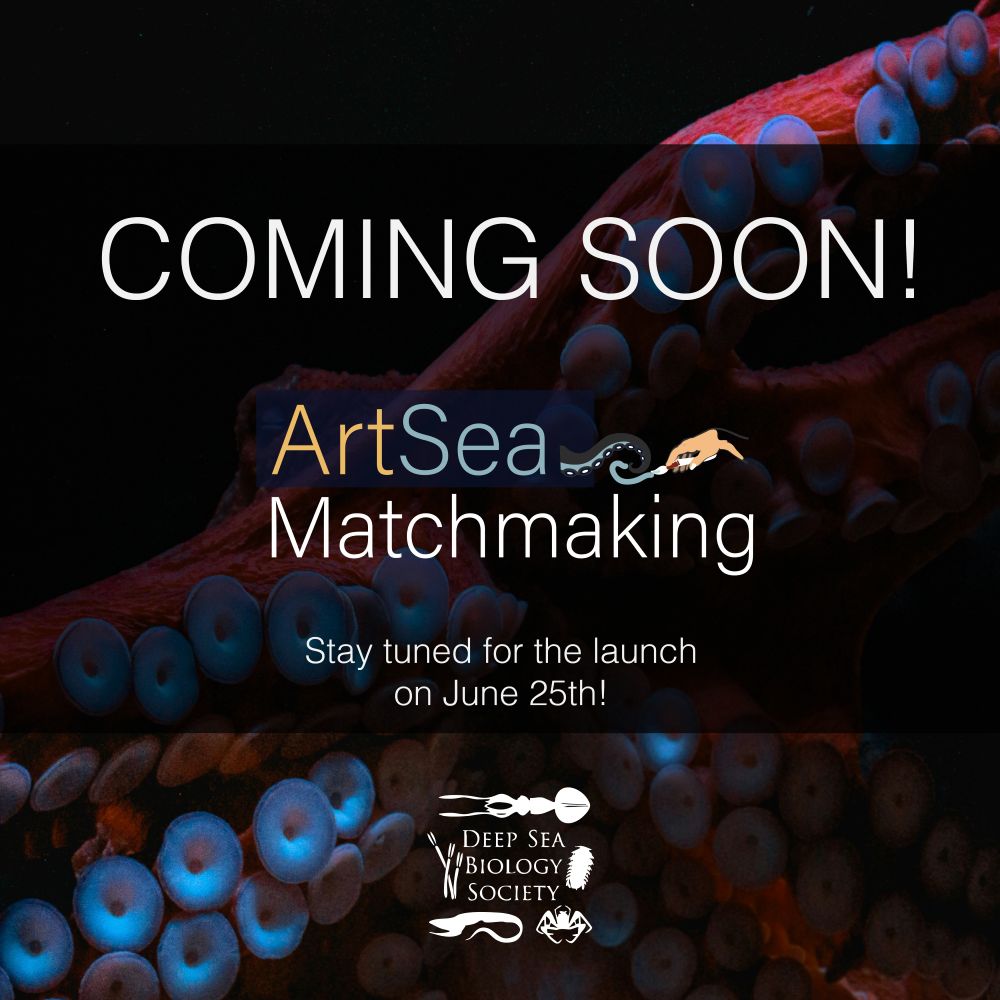
COMING SOON!!
🎨 ArtSea Matchmaking🔬
Curious about this project? We will soon tell you all about it!
Please stay tuned!!
🗓 Launch:
This Wednesday June 25th
#DeepSeaArt #SciArtCollab #DSBSoc #ArtScience #DeepSeaBiology #OceanInspiration #Interdisciplinary
21.06.2025 15:09 — 👍 3 🔁 3 💬 0 📌 1
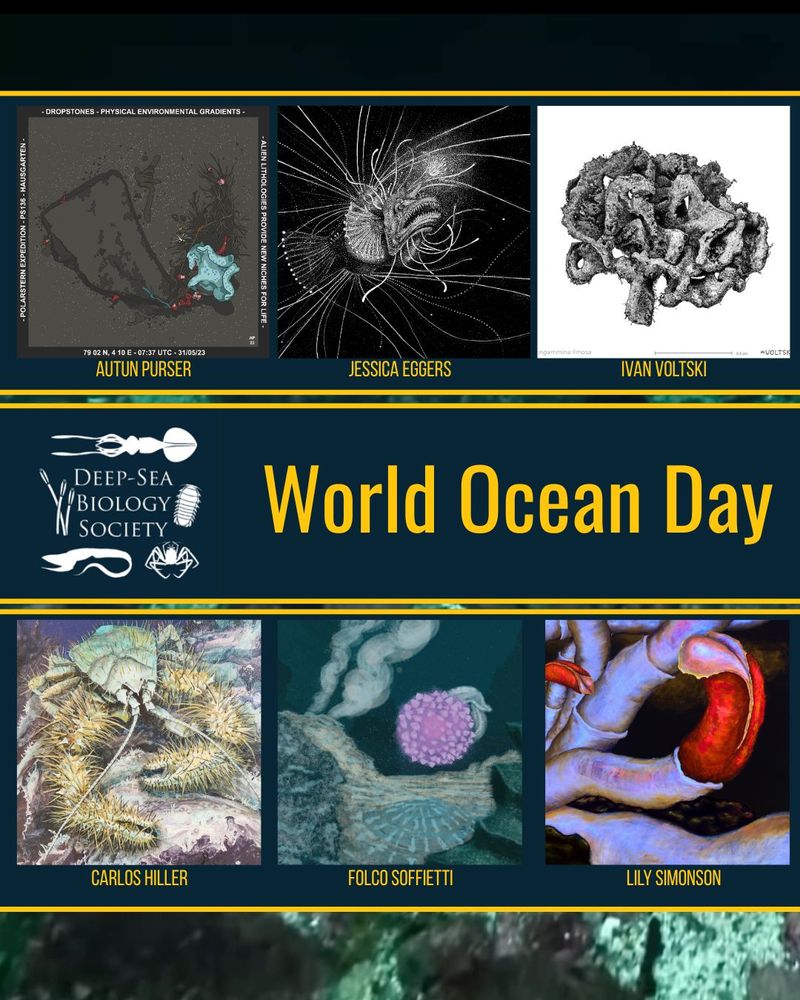
Celebrating World Ocean Day with some Deep Sea art made by DSBSoc-artists. We are all inspired by the deep sea and the science that helps us understand it.
Together, we dive into the unknown and bring the deep to the surface — through color, texture, and imagination.
🌊 Happy World Ocean Day!
Today we celebrate the beauty, mystery, and importance of our oceans — and the creative power of collaboration.
Art made by (from top to bottom, from left to right):
Autun Purser
Jessica Eggers
Ivan Voltski
Carlos Hiller
Folco Soffietti
Lily Simonson
#WorldOceanDay
08.06.2025 12:27 — 👍 12 🔁 5 💬 0 📌 0
Wow, beautiful compliment, thank you!
26.05.2025 05:30 — 👍 0 🔁 0 💬 0 📌 0
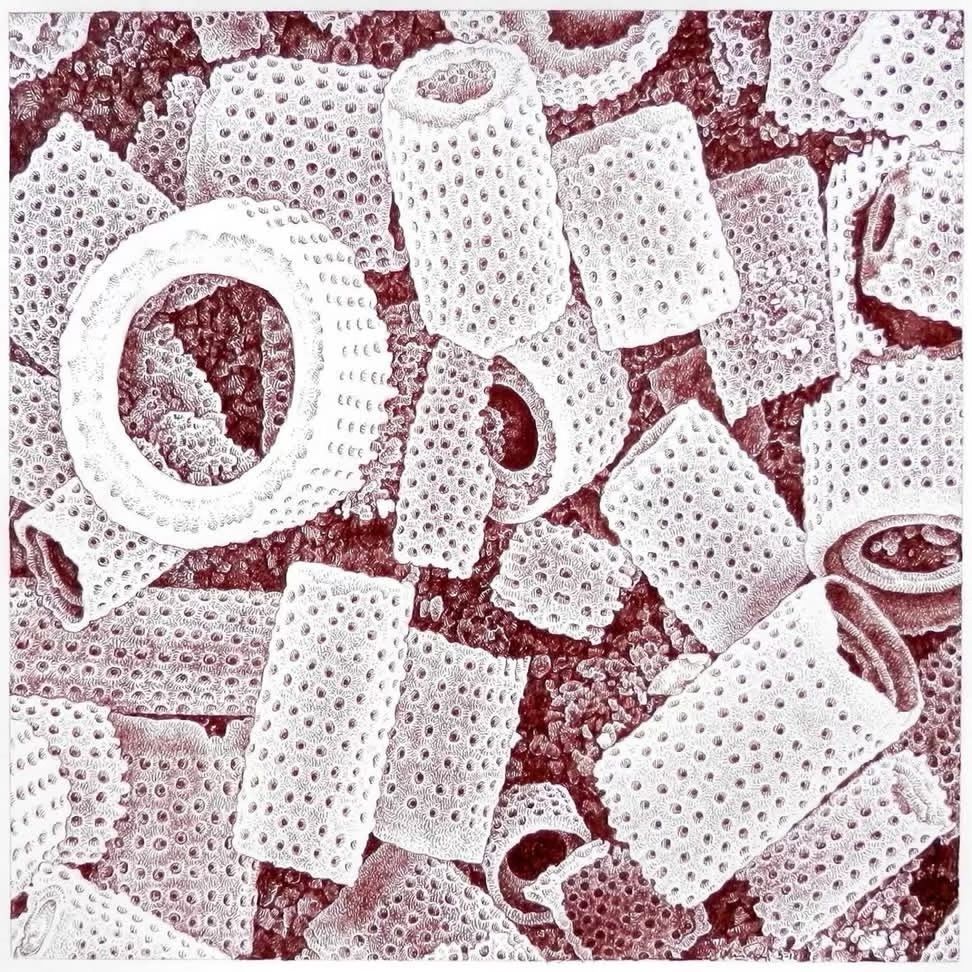
Diatomaceous Earth 2
5/2018 13 X 13 inches [33 X 33 cm] Colored Pencil on Paper
#sciart #gawoski #plankton
25.05.2025 18:38 — 👍 107 🔁 10 💬 1 📌 0
Thank you for your kindness! 💙
25.05.2025 18:12 — 👍 2 🔁 0 💬 0 📌 0
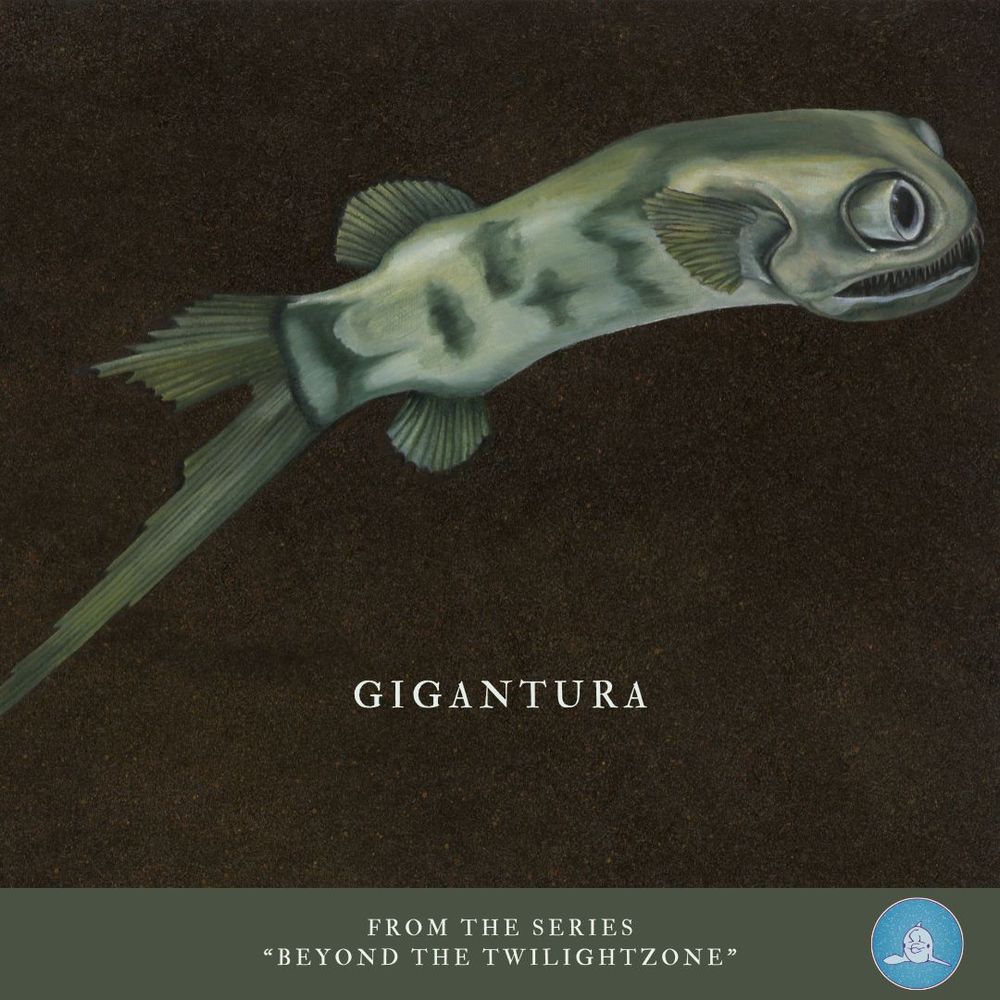
This is an oilpainting of a fish called Gigantura or a telescope fish.
The painting has a dark brown background with a silvery green fish. You could consider it a fairly typical deep-sea fish: it also has a mouth full of needle-shaped, sharp teeth that can slide in and out when catching and eating large prey. I really love the smooth, silvery shine of the fish, it reflects the least amount of light of other bioluminescent creatures. To protect and camouflage itself, it usually swims vertically in the water column.

Detail of the head and the awesome eyes. Telescopic eyes are not uncommon in the deep sea, but usually, they are pointed upward, as in the hatchetfish and the barreleye. Gigantura thus appears to carry binoculars and is hence called telescope fish.
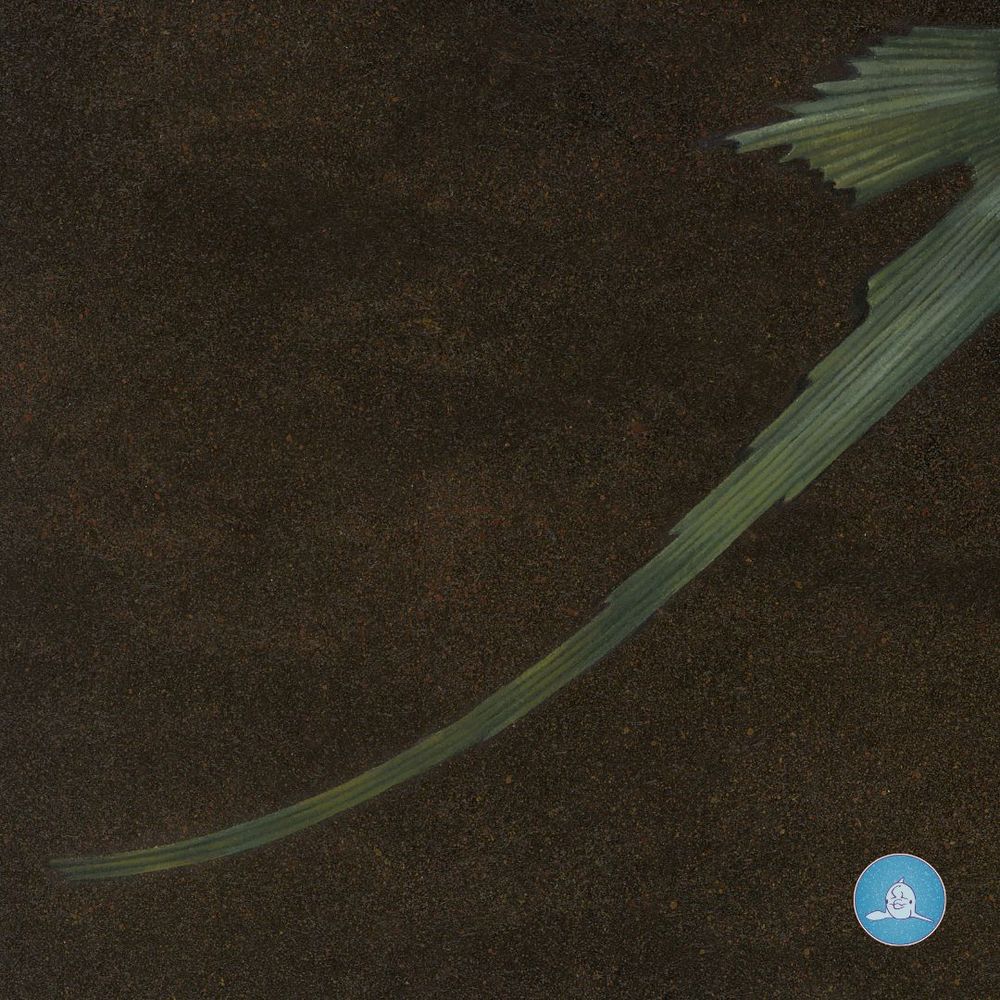
I thought it was important to also show a detail of the caudal fin, since the animal is named after it. Gigantura is a compound name: "giganteus" is Latin and indeed translates to giant, whereas "uras" is Greek and means tail. So, the name refers to the long lower lobe of the caudal fin. The animal itself (including the tail) measures only 5 to 20 cm.
Hi!
Me again, posting another oilpainted fish for #SundayFishSketch
An oilpainting of a Gigantura...
Hope you like it!
If you do, check out www.delphinemestdagh.be to see all my paintings 😊
Love to hear from you in the comments
#sciart #deepsea
25.05.2025 17:41 — 👍 34 🔁 4 💬 1 📌 1
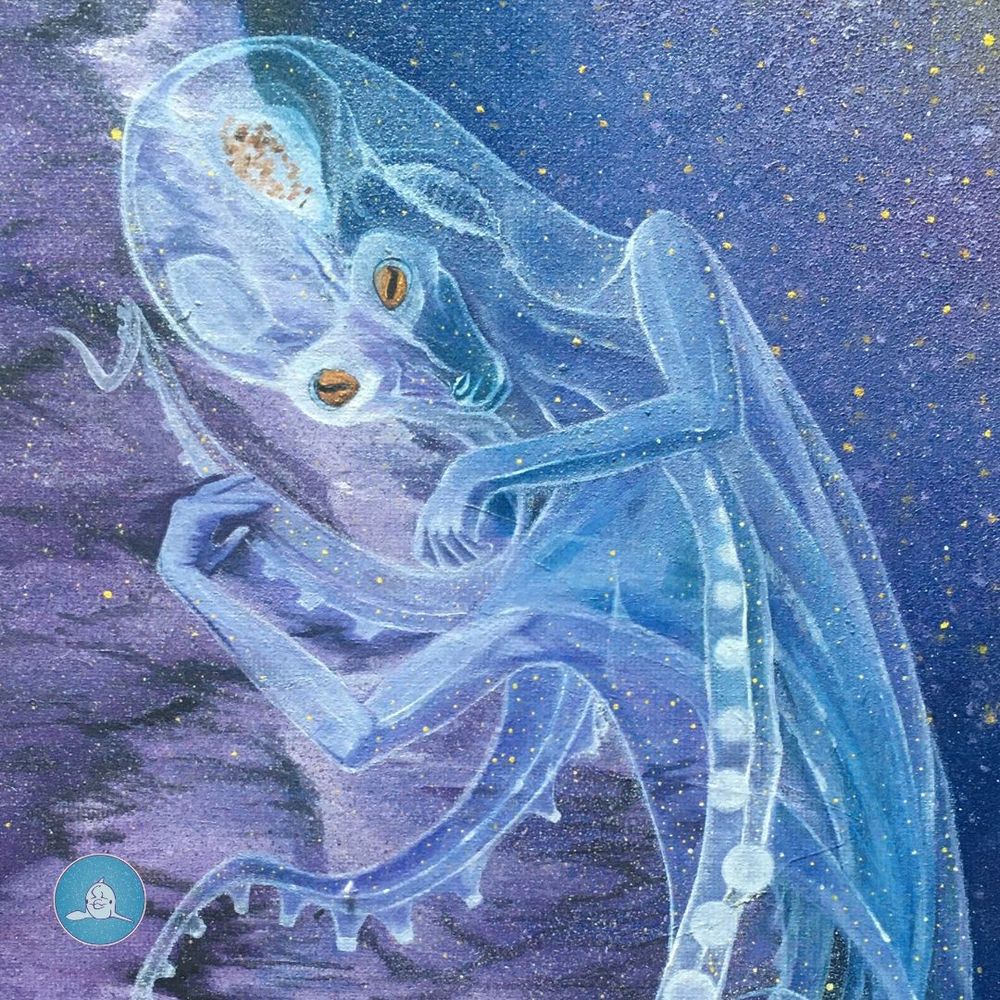
This is a part out of an oil painting showing an alien-like mermaid floating in the abyss, with a rocky wall as a background. I based this creature on an octopus, painting the tentacles and a transparent head. The colors I used are mainly violets and blues with sparks of yellow for contrast. The eyes of the mermaid are also yellow and based on those of an octopus.
Hi y'all!
I wanted to share this painting I made some time ago for #MerMay
Hope you like it 😊
16.05.2025 18:40 — 👍 11 🔁 4 💬 0 📌 0
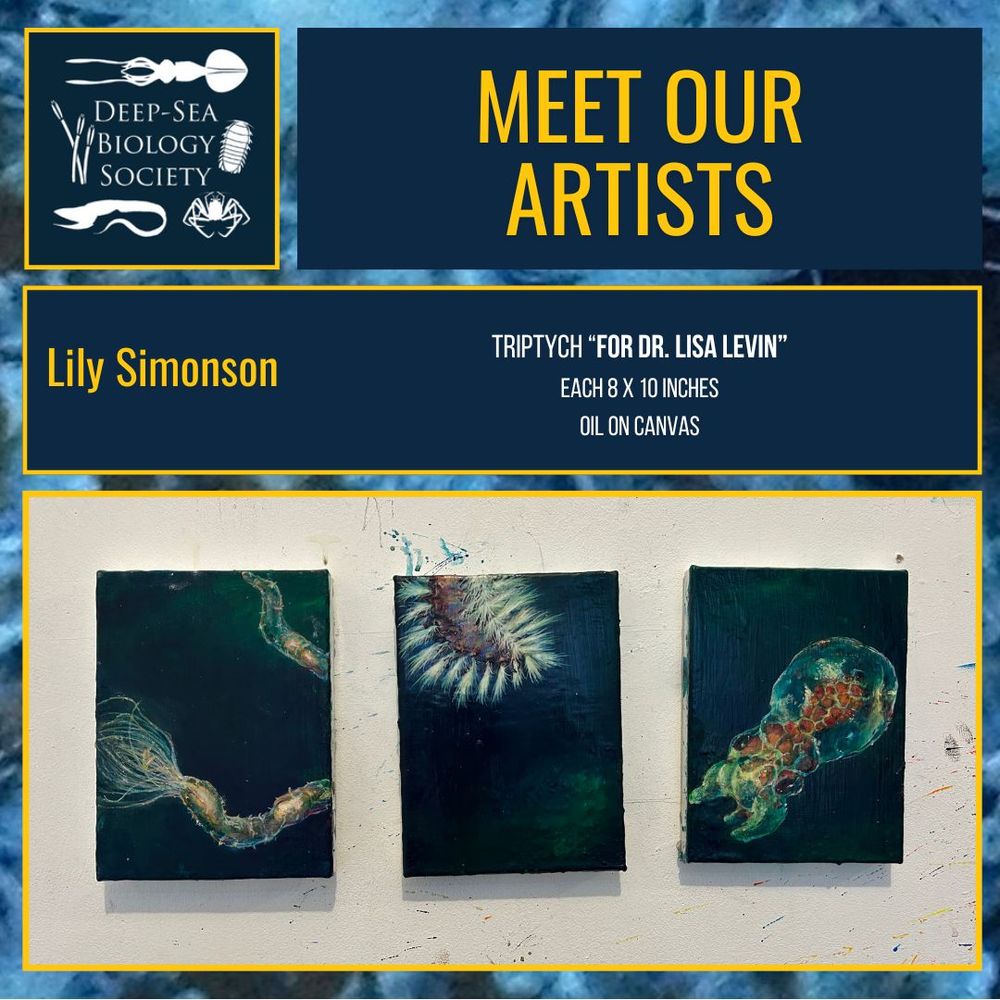
Lisa’s statement about the triptych “For Lisa Levin”:
“Enveloping the viewer in atmospheric, outsize scenes of bizarre sea creatures and remote habitats, my paintings highlight the shifting space between human beings and the natural world. Collaborating with scientists in Antarctica and the deep sea, I invoke the history of artists and scientists working in tandem to share new discoveries. Dr. Lisa Levin was the first deep sea scientist I ever accompanied on an expedition and has shaped my entire trajectory as an artist. I painted this series on the occasion of her retirement. The first painting of Fabricia limnicola represents Dr. Levin’s early PhD work, Archinome levinae her namesake scaleworm and represents the incredible influence she has had on the deep sea community, and the octopus larvae is based on the research of Levin’s final PhD student, Dr. Lilly McCormack who commissioned the work.”
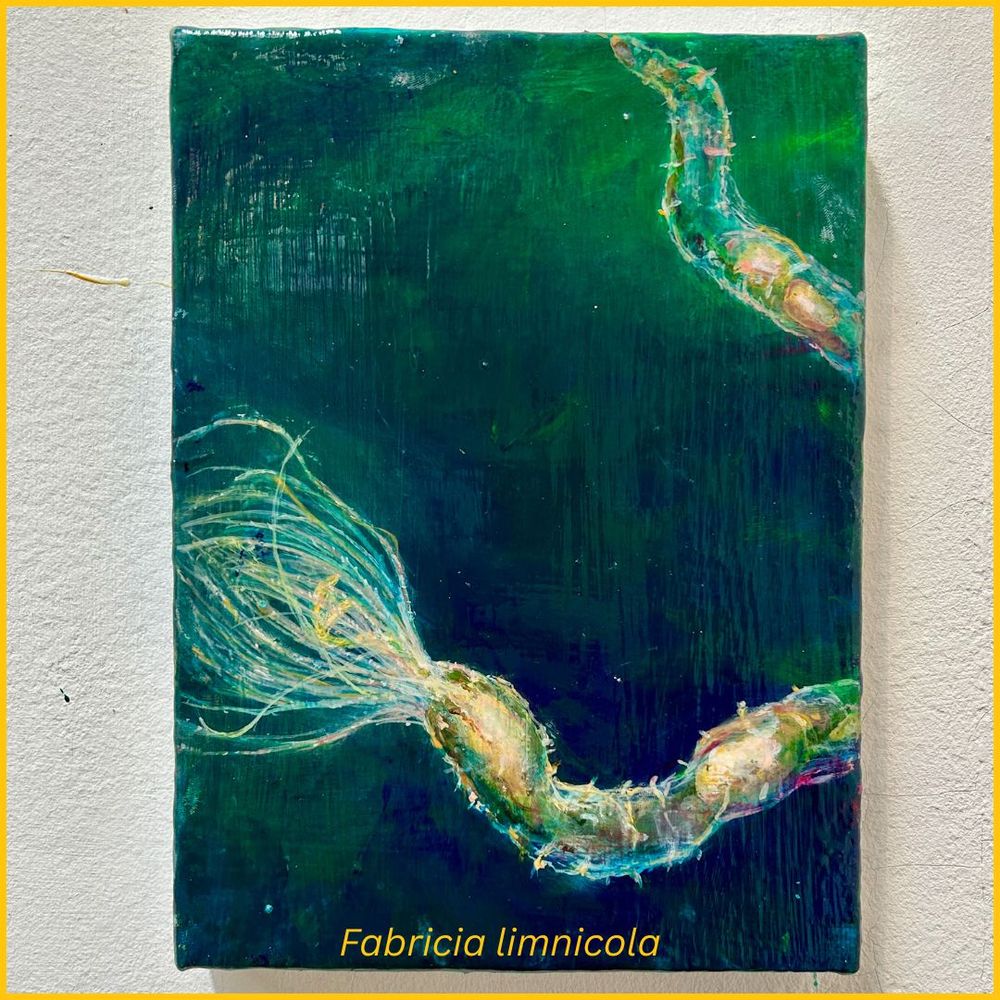
A series of three paintings on dark turquoise backgrounds. The first painting shows a translucent worm with thread-like protrusions from the end of its body.
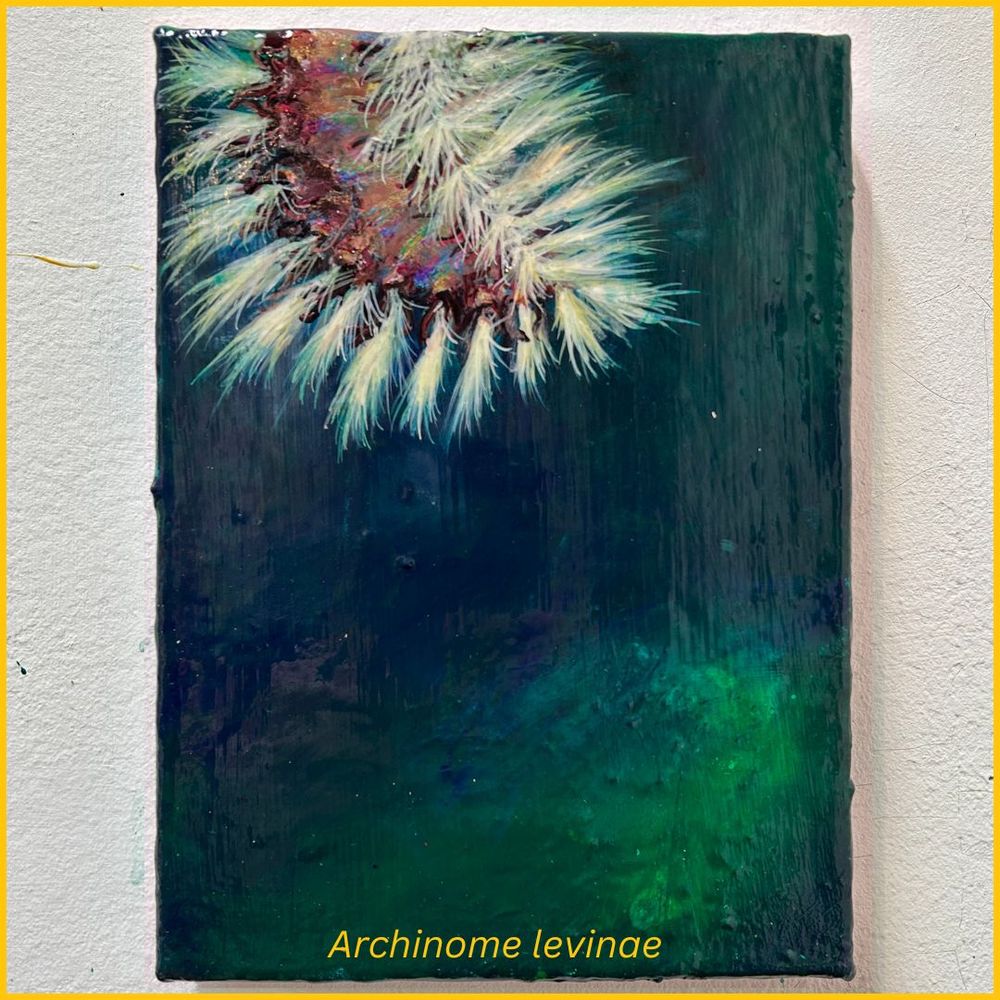
The middle painting depicts a fat marine bristle worm with iridescent scales covering its body and clusters of bristles at on either side of each segment.
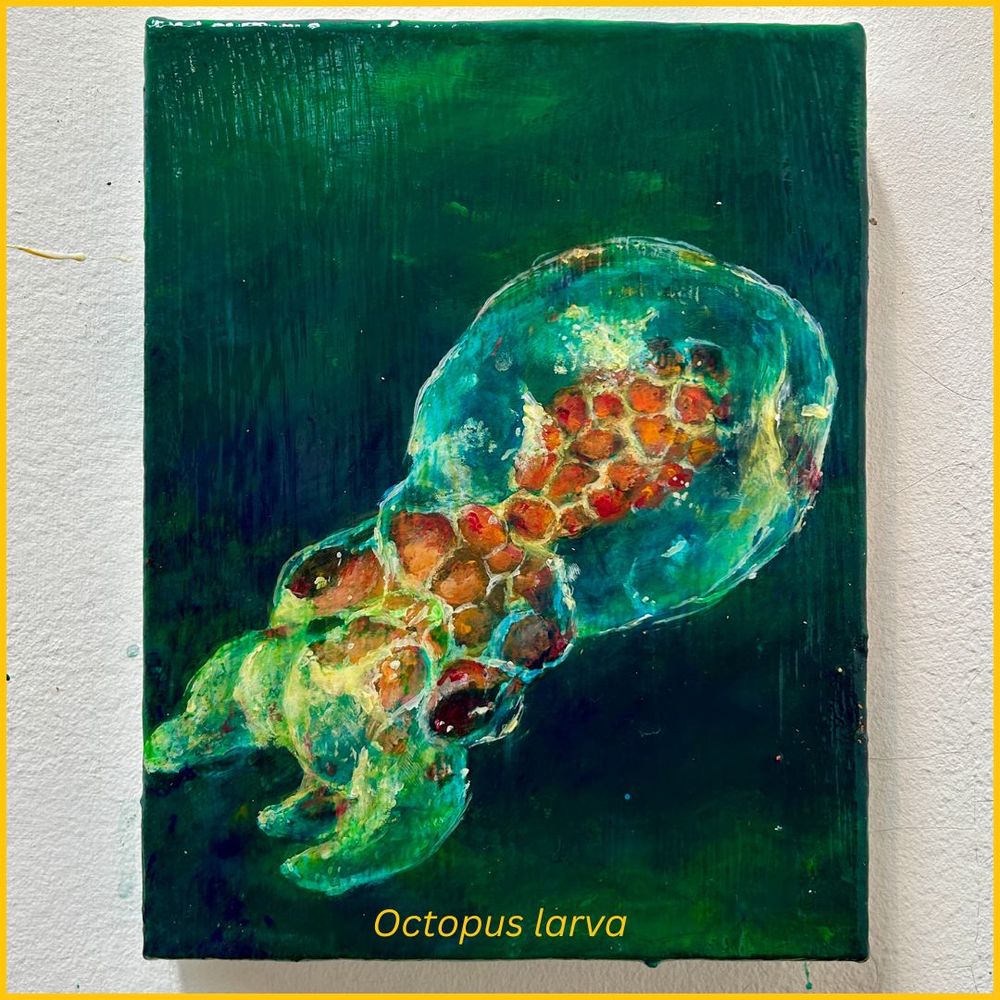
The third painting depicts a translucent larval octopus.
MEET OUR ARTISTS
Lily Simonson
@oldgenres.bsky.social
Be welcome to visit lilysimonson.com to see more of Lisa’s work.
For more about @dsbsoc.bsky.social , please follow our main account and visit dsbsoc.org
#artandscience #bridgingartandscience #triptych
13.04.2025 09:57 — 👍 9 🔁 3 💬 0 📌 0
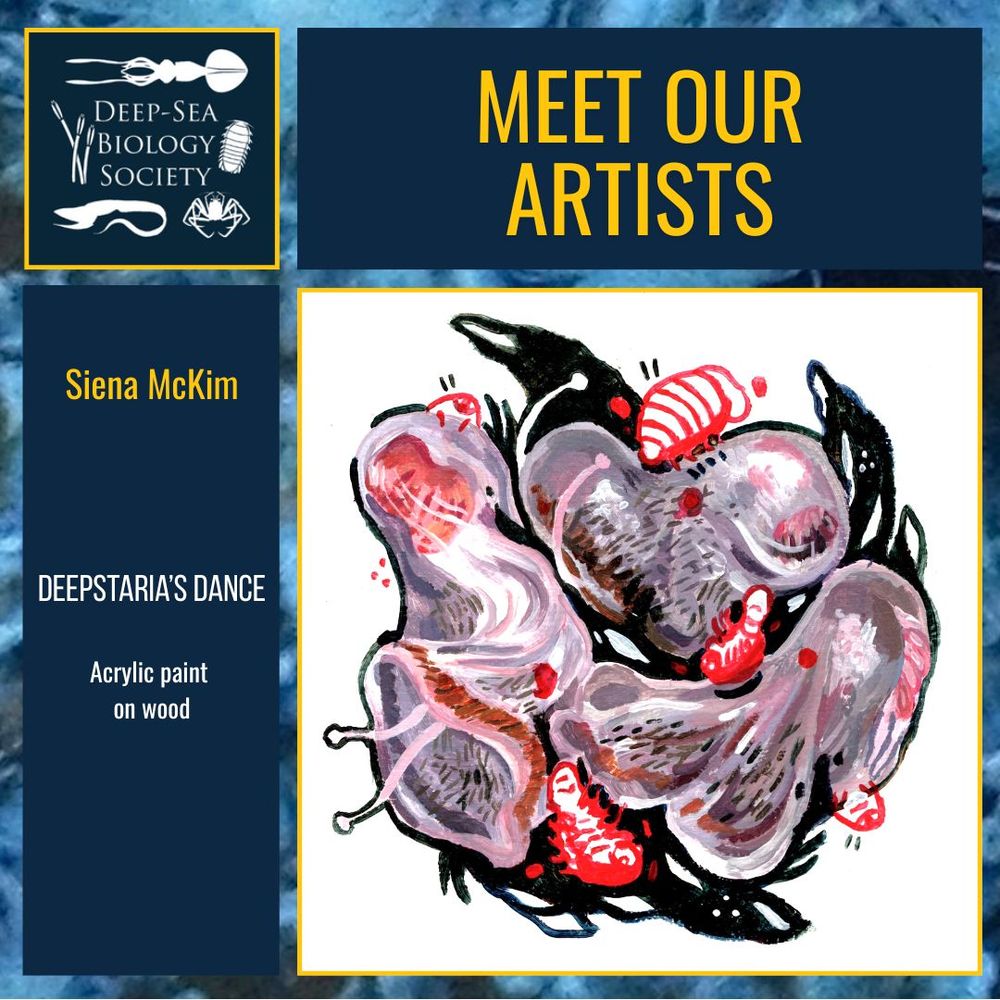
About Deepstaria’s Dance:
“Deepstaria is a shape shifting jellyfish that undulates its pink sheet-like umbrella into mesmerizing shapes. When the umbrella moves in the right way, an isopod inhabitant is revealed. The isopod and it’s mutating Deepstaria home dance together in the deep.”
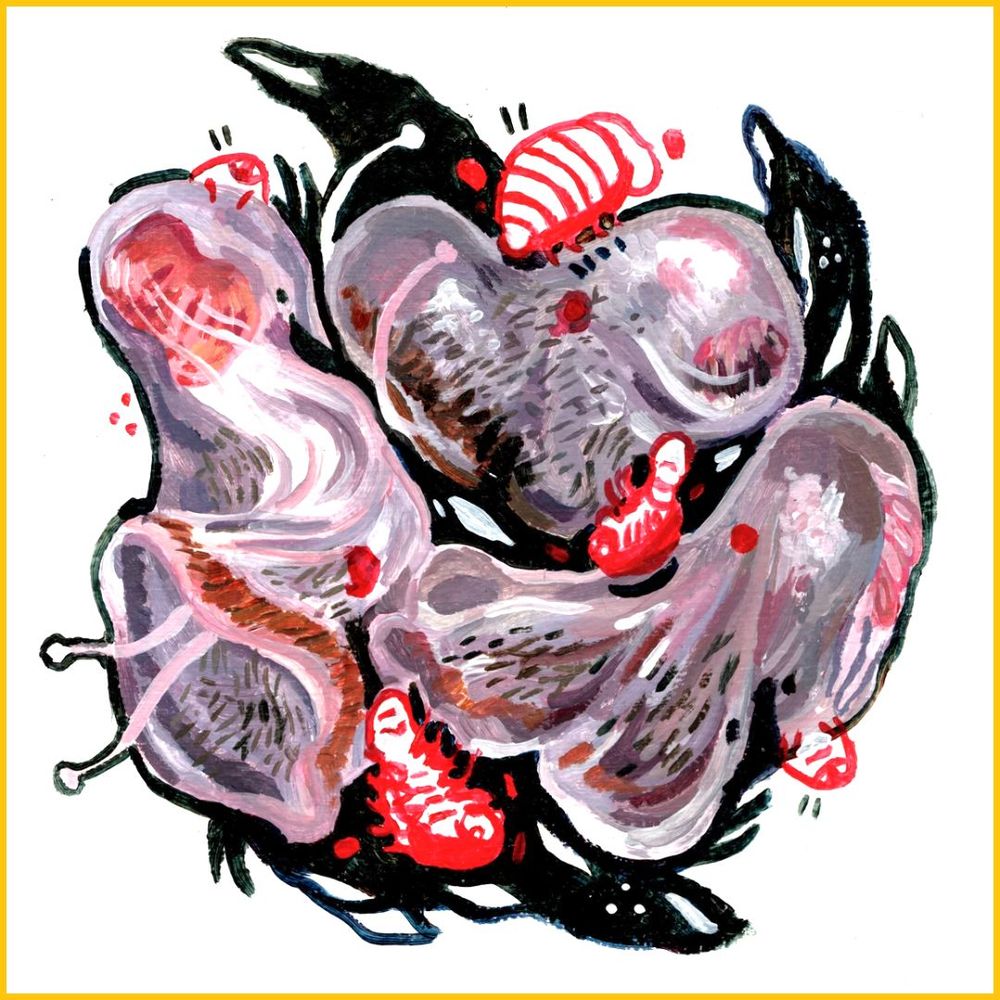
Artist Statement:
“Growing up surrounded by ocean nature documentaries and books, fantasy and sci-fi media didn’t interest me as I saw that the life in our oceans were stranger than anyone’s imagination. One of the first memories I have is observing a giant illustration of a gulper eel with its gaping mouth big enough to threaten my small body. From then on, I have always been awe-inspired by the strange and curious bodies of the deep, including the organisms, like sponges and corals, that blend into the landscapes becoming homes for others. Because these deep-sea landscapes and organisms are inaccessible to air breathing humans, imagery through writing and art are our bridges to this world. Both art and science explore the themes of deep-sea stories including ecological and evolutionary relationships, processes, and outcomes. Science and art are already bridged in their shared goal of exploring this strange world, but this is not always obvious. Thus, as an artist and a scientist, I feel driven to make this connection more obvious and feed people’s curiosity. The deep-sea biological sciences have revealed more about our Earth than ever before teaching us to never doubt the wealth of biodiversity that has evolved and the resilience of these organisms. Using a diverse range of mediums, I use my art to showcase this biodiversity and explore the themes of home and change.”
MEET OUR ARTISTS
Today we present Siena McKim with her acrylic painting Deepstaria's Dance. Read more about this beautiful artwork and about Siena in the ALT-Text.
Follow our main account @dsbsoc.bsky.social for more about us!
Visit dsbsoc.org for more Art & Science!
#deepsea #contemporaryart
07.04.2025 15:19 — 👍 2 🔁 2 💬 0 📌 0
Floating through inner space ✨️
This species of jellyfish, Poralia rufescens, is one most people will never see. It lives deep below the sea surface to thousands of meters and is usually seen floating near the seafloor, sometimes we see hundreds of them on an ROV dive!
27.03.2025 20:47 — 👍 85 🔁 29 💬 0 📌 1
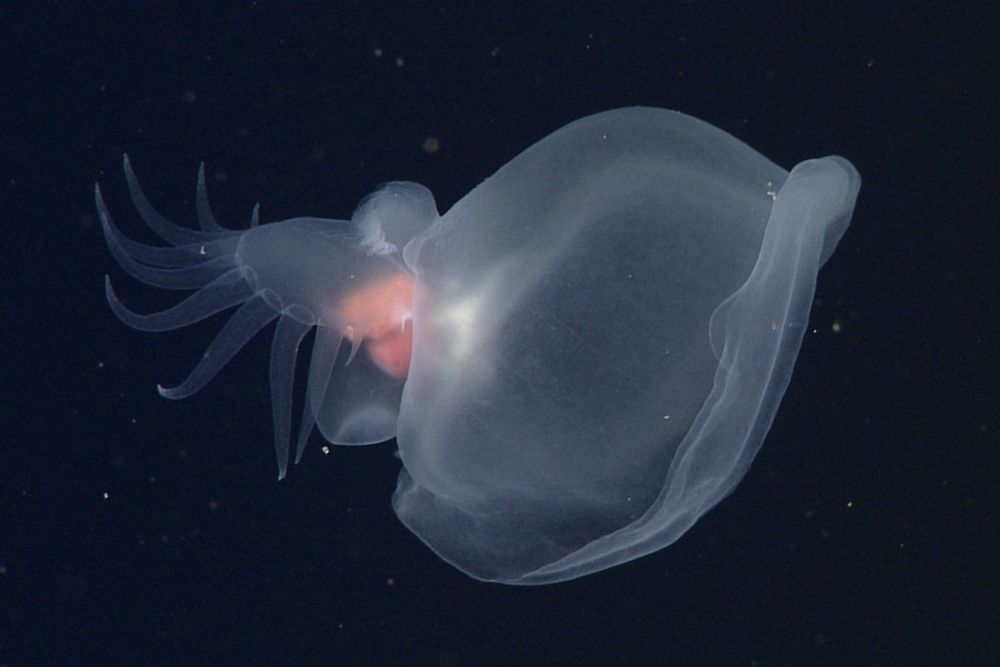
MBARI researchers discover remarkable new species of swimming sea slug • MBARI
A new nudibranch species is the first known to inhabit the ocean’s midnight zone and has unique adaptations for life in this environment.
MBARI researchers have discovered a remarkable new species of sea slug in the deep sea. Nicknamed the "mystery mollusc," the nudibranch Bathydevius caudactylus swims through the midnight zone and lights up with brilliant bioluminescence.
Learn more: www.mbari.org/news/mbari-r...
12.11.2024 17:54 — 👍 241 🔁 81 💬 4 📌 8
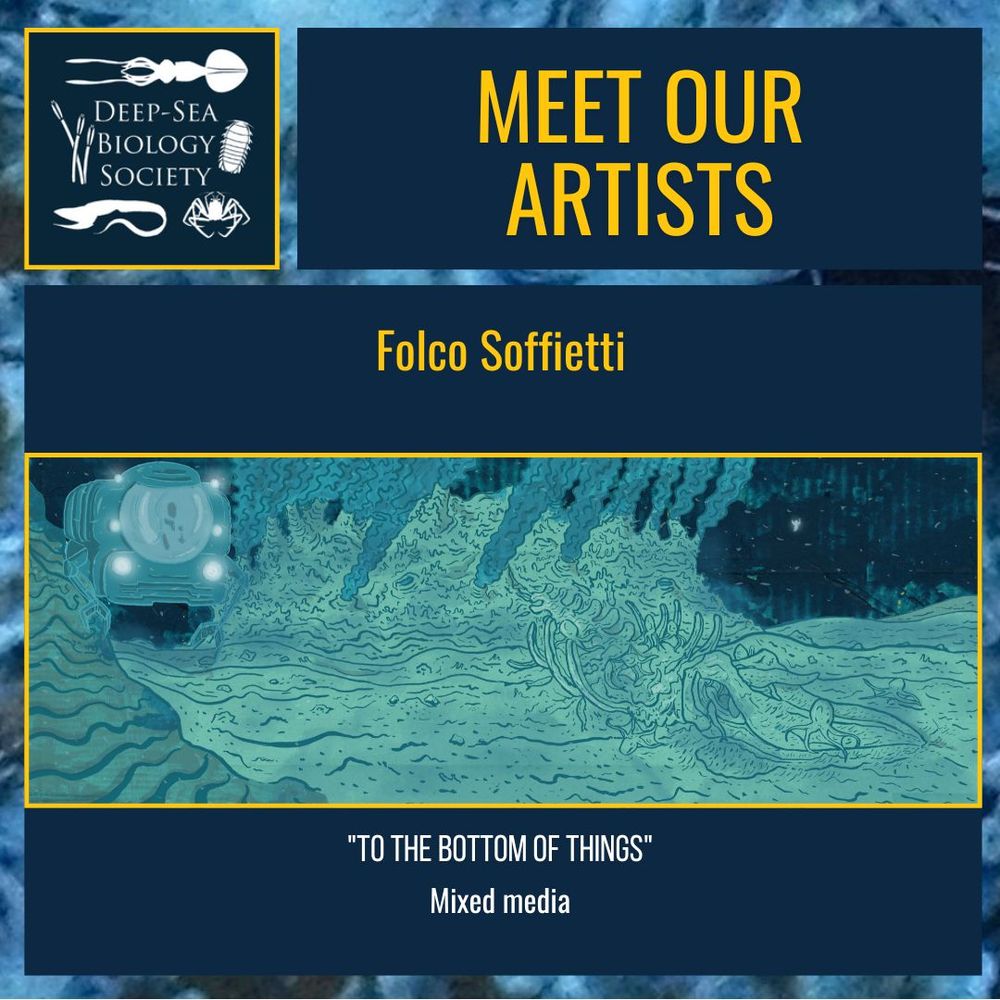
"To the Bottom of Things" shows an ROV exploring the ocean floor and octopuses feeding on a whale carcass. The piece is about life continuing and events unfolding on the seabed, it is actually a mixed-media artwork. The drawing was done with ink and then digitally coloured, adding textures from acrylic painting. It's beautifully detailed, with for example a light speck that turns out to be a sea angel.
Artist statement:
“I typically use digital techniques to create layered compositions and luminescent effects that evoke a sense of something otherworldly—almost like a vision from outer space or a piece of science fiction madness.
Whether it’s the marine life itself or the sheer depth of exploration required to uncover its secrets, the deep sea feels entirely alien. The beauty of it is that no matter how precise or detailed you get, the magic never fades. Whether zooming in on intricate close-ups or crafting an entire immersive scene, the result always carries an edge—like stepping into a brand-new sci-fi series.”
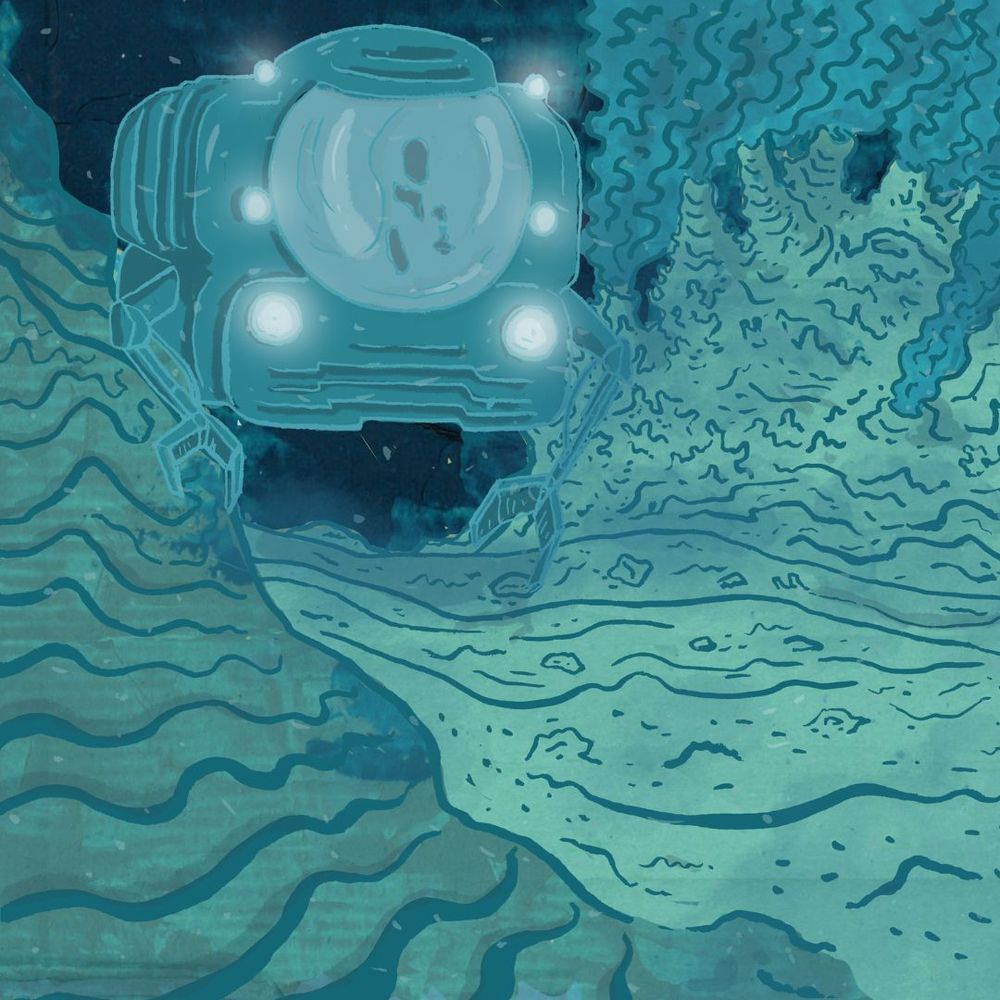
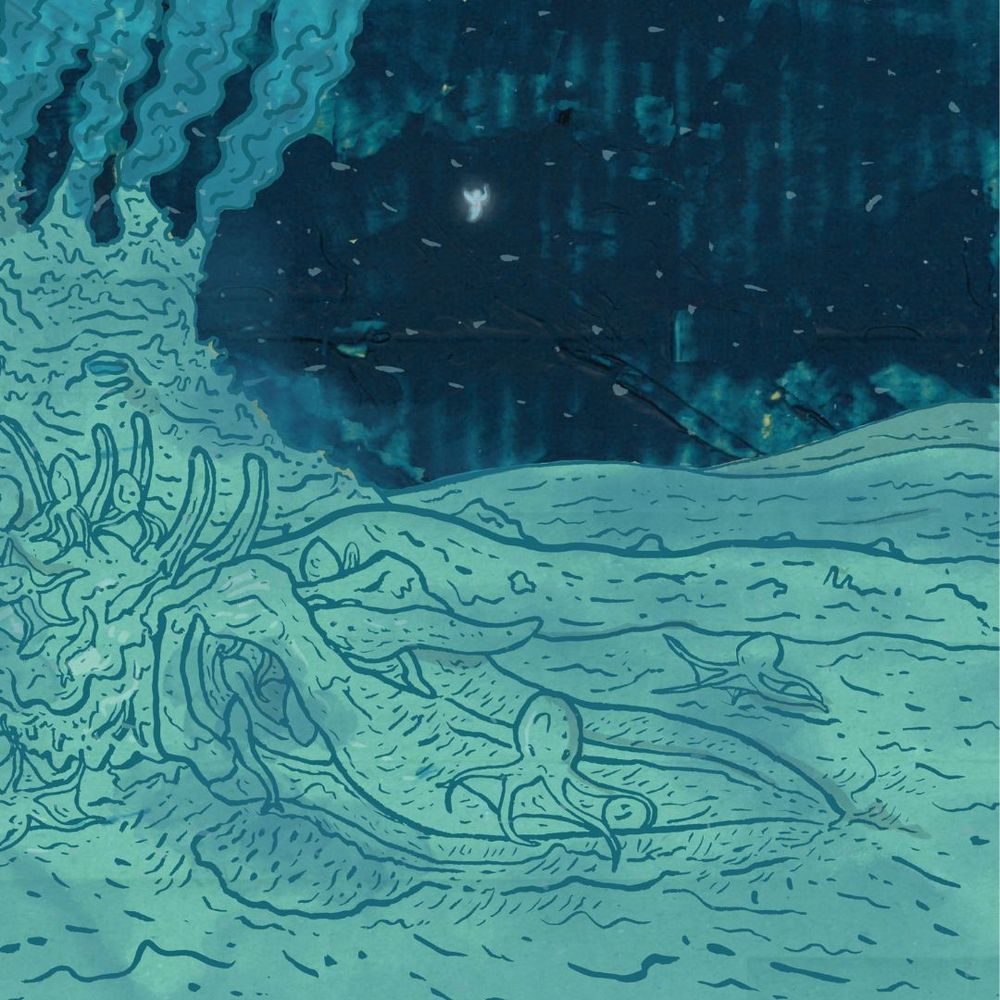
MEET OUR ARTISTS 🌊🌊🌊
Folco Soffietti
With a mixed media artwork “To the bottom of things”, a mesmerizing piece about life continuing and events unfolding on the seabed.
You can find an artist statement in the ALT-text 😊
Follow us and our main account @dsbsoc.bsky.social for more art & science
21.03.2025 08:48 — 👍 10 🔁 2 💬 0 📌 1
Merci beaucoup! 🙏🏻
17.03.2025 06:13 — 👍 0 🔁 0 💬 0 📌 0
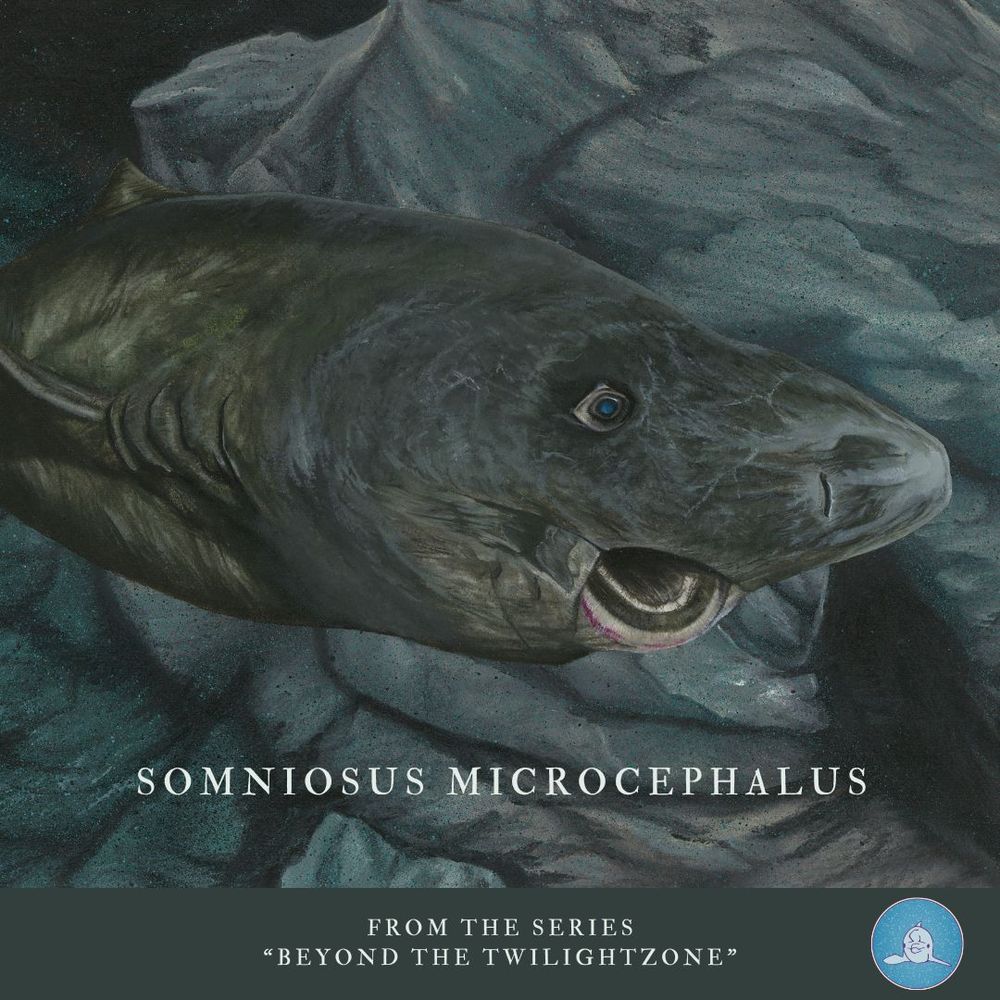
I'm introducing another painting from my series "Beyond the Twilightzone". It's a Greenland shark that I painted completely with a grayish green palet.
In Beyond the Twilightzone I wrote about this fish:
"The Greenland shark is a true record-breaker. First, they live in the cold waters from Canada to Norway and at 7 meters, they are the largest Arctic fish.
They grow slowly, only one cm per year. This is due to their slow metabolism. Actually, everything goes a little slower with this giant: they also swim slowly. This has made the shark an opportunistic hunter but also a scavenger. It eats fish, seabirds, seals and also drowned land animals such as reindeer.
During the cold winters, sharks often swim on the surface and have a chance to encounter such morsels.
They also age slowly. The Greenland shark is the longest-lived vertebrate in the world and is estimated to likely live for over 400 years! Think for a moment what times this shark has swum through! Humanity in Europe was busy with the likes of Mozart, Darwin and Napoleon.
Meanwhile, this giant wandered ignorantly into the depths. That is if it was not being caught by humans. Until 1960, they were fished en masse for their liver oil. Their meat is also poisonous unless smoked or double-cooked.
Moreover, their slow metabolism may account for their longevity, but also the fact that they only become sexually mature after 150 years! The eggs are incubated internally, and only ten young are born.
All this together makes Somniosus microcephalus very vulnerable, and it takes a long time for the population to recover."
Hi everybody!
Introducing my Greenland Shark for #sundayfishsketch
I hope you like it ☺️
If you do, let me know, I love hearing from you!
You can see all my artwork on my website www.delphinemestdagh.be
16.03.2025 16:31 — 👍 50 🔁 10 💬 1 📌 0
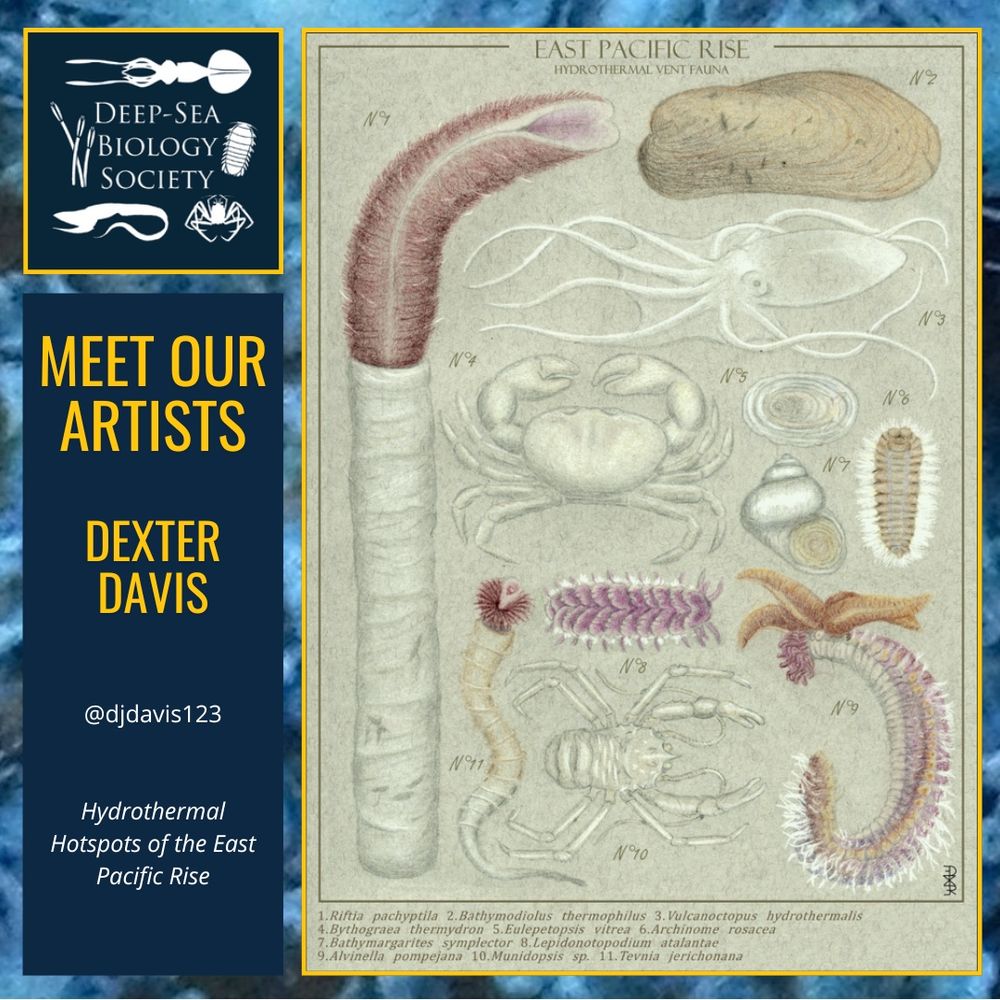
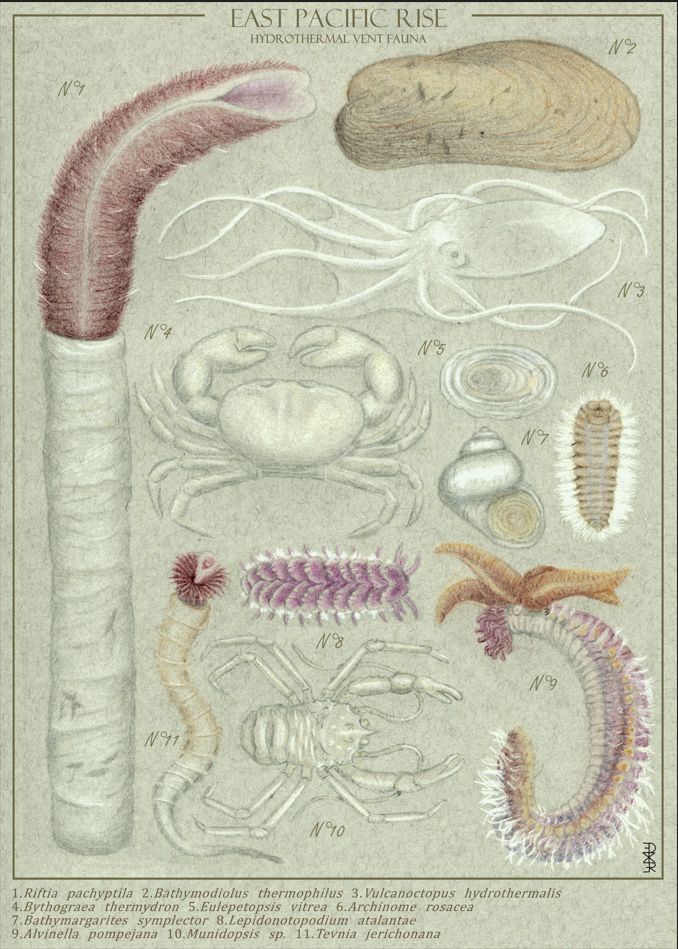
Introducing Dexter Davis, a deep-sea biologist interested in communicating his science through art. His work is inspired by traditional taxonomic plates - such as this beautiful illustration of characteristic hydrothermal vent fauna of the East Pacific Rise. #dsbsoc #sciart #dsbs #dsbsart
15.03.2025 13:17 — 👍 33 🔁 6 💬 2 📌 0
![Presenting another DSBSoc-artist named Véronique Robigou with her painting "Deep Sea Oasis"
Véronique wrote about this artpiece:
"As a marine geologist, I mapped unexplored territories of seafloor and underwater volcanoes with deep submergence vehicle including DSV Alvin. And decades later, vivid, retinal vestiges of ocean landscapes that I explored still inspire my artwork. Deep Sea Oasis is my impression of a fairy castle, hot spring that rises from the inky black, basaltic ocean floor. On a dive with chief scientist J. R. Delaney, and Alvin pilot D. Foster we discovered the High-Rise hydrothermal vent field on July 17, 1991. It lies on the northern segment of the Juan de Fuca Ridge which is a spreading center off the coasts of Oregon, Washington, and British Columbia. The Pacific and North American tectonic plates are born at and spread away from this volcanic ridge. Subsequent mapping in September 1991 unveiled spectacular, geyser-like towers gushing unusually large, rising plumes of metal-laden, hot water. These sulfide-rich, mineral edifices are called hydrothermal vents and spew fluids at temperatures up to 400°C [752 °F] through chimneys and upside-down cascading flanges."
More about "Deep Sea Oasis" in the next ALT-text](https://cdn.bsky.app/img/feed_thumbnail/plain/did:plc:7ql4q76gbznue7dsi6nrsegu/bafkreiaxb2cjgvuzi6qcmv22mdgy7sywjhwgaebfsnlg77rwl73ec66jhy@jpeg)
Presenting another DSBSoc-artist named Véronique Robigou with her painting "Deep Sea Oasis"
Véronique wrote about this artpiece:
"As a marine geologist, I mapped unexplored territories of seafloor and underwater volcanoes with deep submergence vehicle including DSV Alvin. And decades later, vivid, retinal vestiges of ocean landscapes that I explored still inspire my artwork. Deep Sea Oasis is my impression of a fairy castle, hot spring that rises from the inky black, basaltic ocean floor. On a dive with chief scientist J. R. Delaney, and Alvin pilot D. Foster we discovered the High-Rise hydrothermal vent field on July 17, 1991. It lies on the northern segment of the Juan de Fuca Ridge which is a spreading center off the coasts of Oregon, Washington, and British Columbia. The Pacific and North American tectonic plates are born at and spread away from this volcanic ridge. Subsequent mapping in September 1991 unveiled spectacular, geyser-like towers gushing unusually large, rising plumes of metal-laden, hot water. These sulfide-rich, mineral edifices are called hydrothermal vents and spew fluids at temperatures up to 400°C [752 °F] through chimneys and upside-down cascading flanges."
More about "Deep Sea Oasis" in the next ALT-text
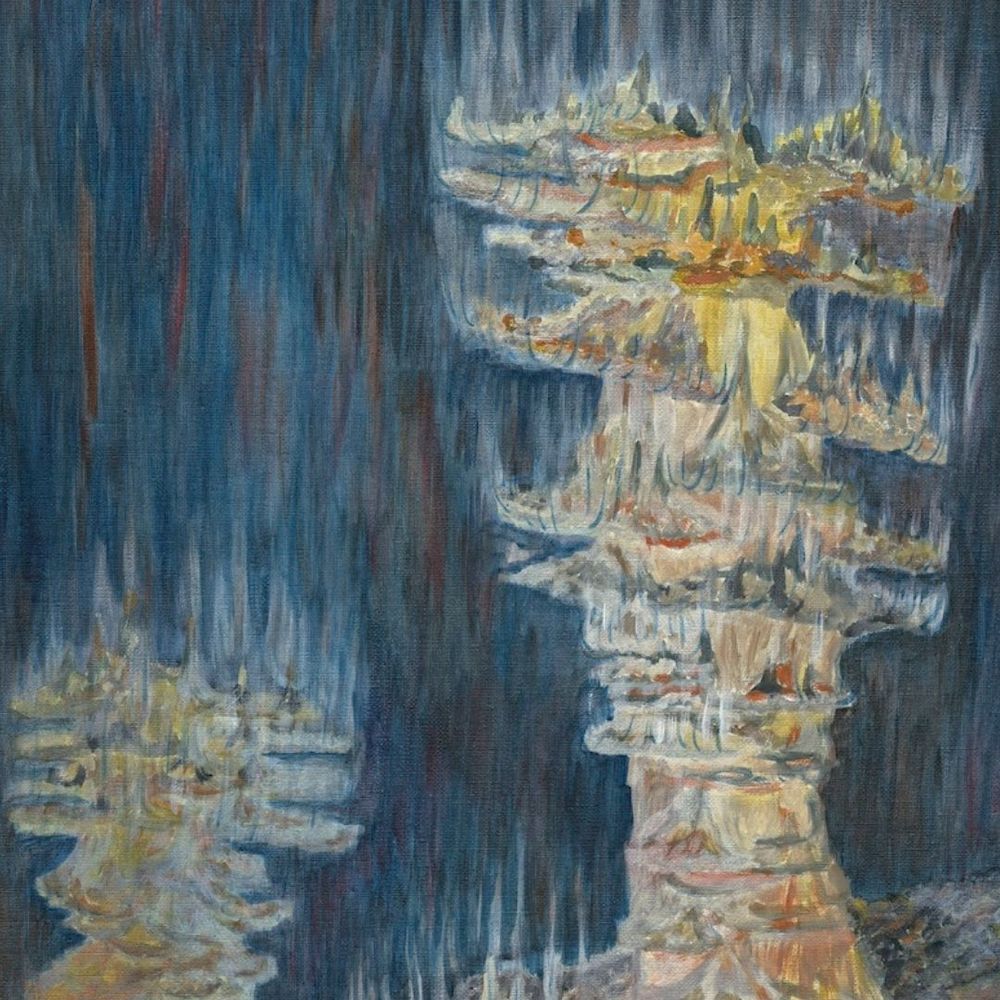
"The tallest hydrothermal vent towered 45 meters above the pillow lava at 2200 meters depth. Named Godzilla by Alvin pilots for its massive stature, the threat of this large colossus combined to unpredictable currents at depth inspires not only reverence but caution. As the submersible illuminating the darkness negotiates a safe path through a forest of these sulfide giants and their monstrous shadows my heart is pounding inside my chest. However, the beauty, mystery, and peace of the Prussian blue scenery soon enchants the diver. Soon the looming menace of the gargantuan vents disappears and the vibrant colors of the luxuriant animal communities that engulf the sulfide bluffs ignite curiosity and awe. Just as an oasis offers comfort to the weary caravan traversing the desert, hydrothermal vents provide shelter and nutrients to species that favor geothermal energy over sunlight. These endemic vent species thrive on toxic volcanic gases in the complete obscurity of great depths. Deep sea oases are densely colonized by thick layers of extraordinary creatures - blood-red plumes of gills emerge from white tubes adorn vestimentiferan worms; bright orange palm worms sway in unison bathing in hydrothermal fluid; hyperactive sulfide worms spring out of their mucus and harvest the hottest fluids; and myriads of scale worms, lepitodrilus fucensis limpets and buccinum snails graze bacteria that cloak all surfaces of the vents and their inhabitants."
Thanks for reading!
MEET OUR ARTISTS
Véronique Robigou
www.oceanetterrastudio.com
For more information about DSBSoc, follow our main account
@dsbsoc.bsky.social
or visit our website dsbsoc.org
#artandscience #sciart #sciartist #deepsea #deepseartist #contemporaryartist #contemporarypainter
07.03.2025 13:19 — 👍 11 🔁 3 💬 0 📌 0
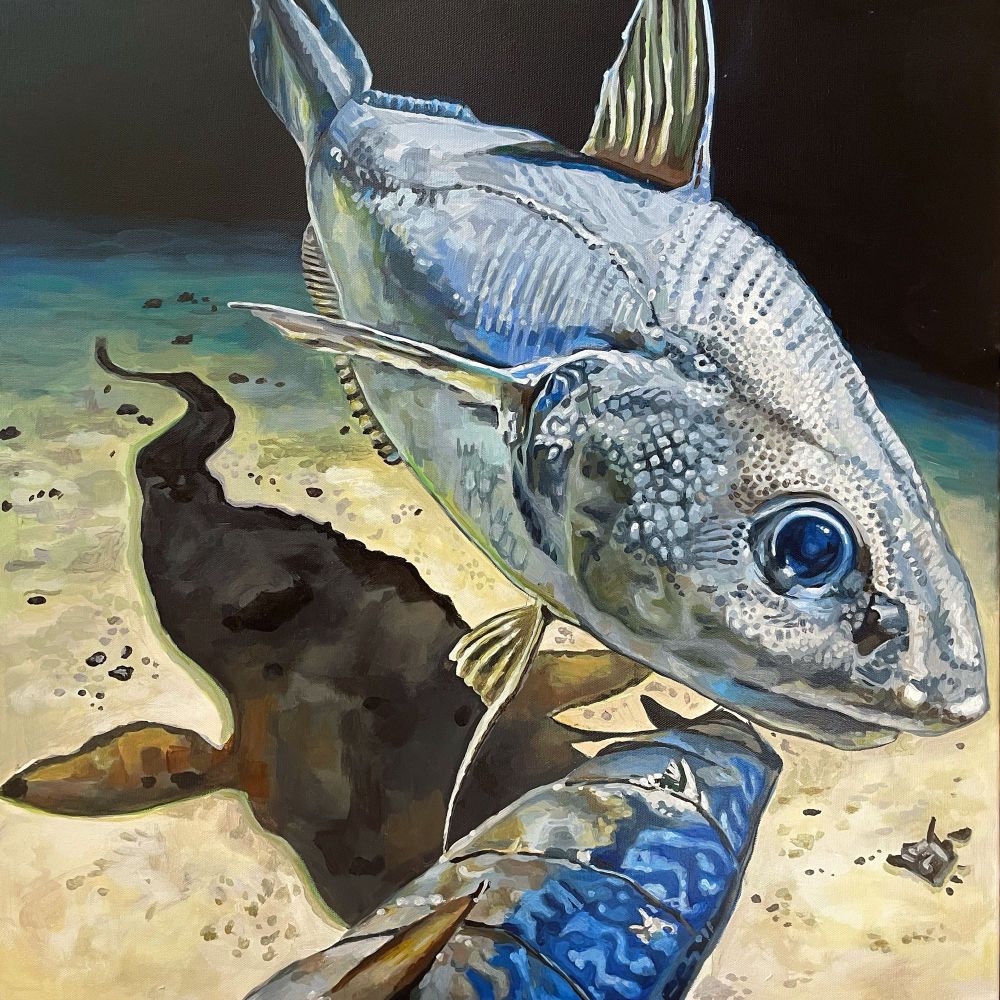
Deep ocean grenadier fish with a large blue eye swimming over a striped blue mackerel bait #SciArt #deepsea
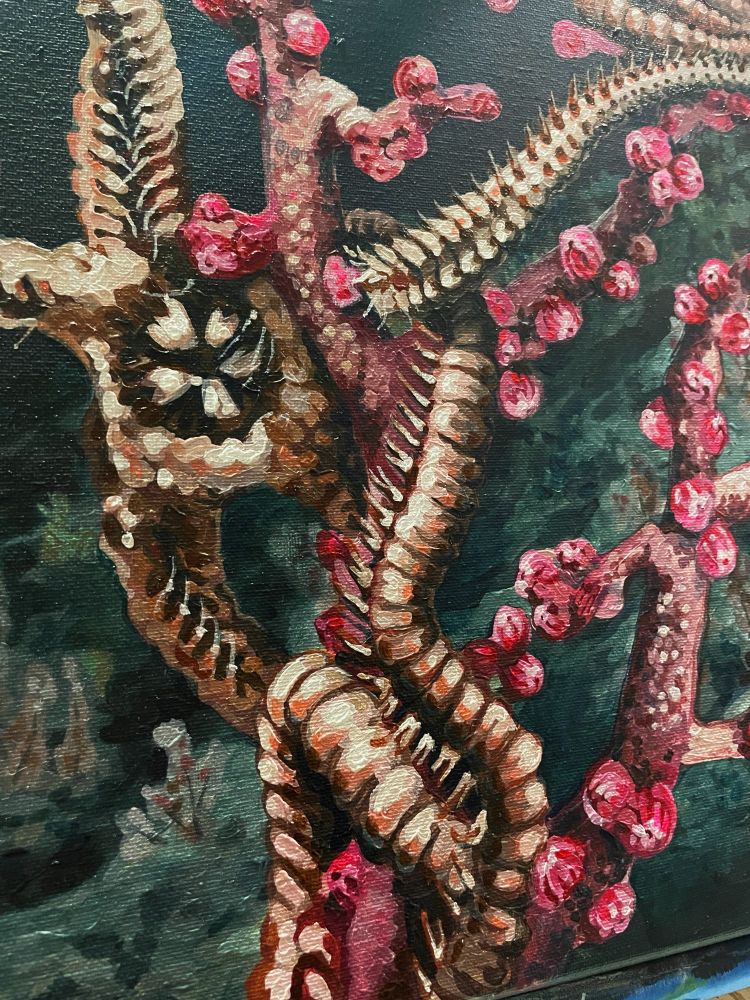
Brittle star twining around a pink bubblegum coral #SciArt #deepsea #deepseacreatures #brittlestar
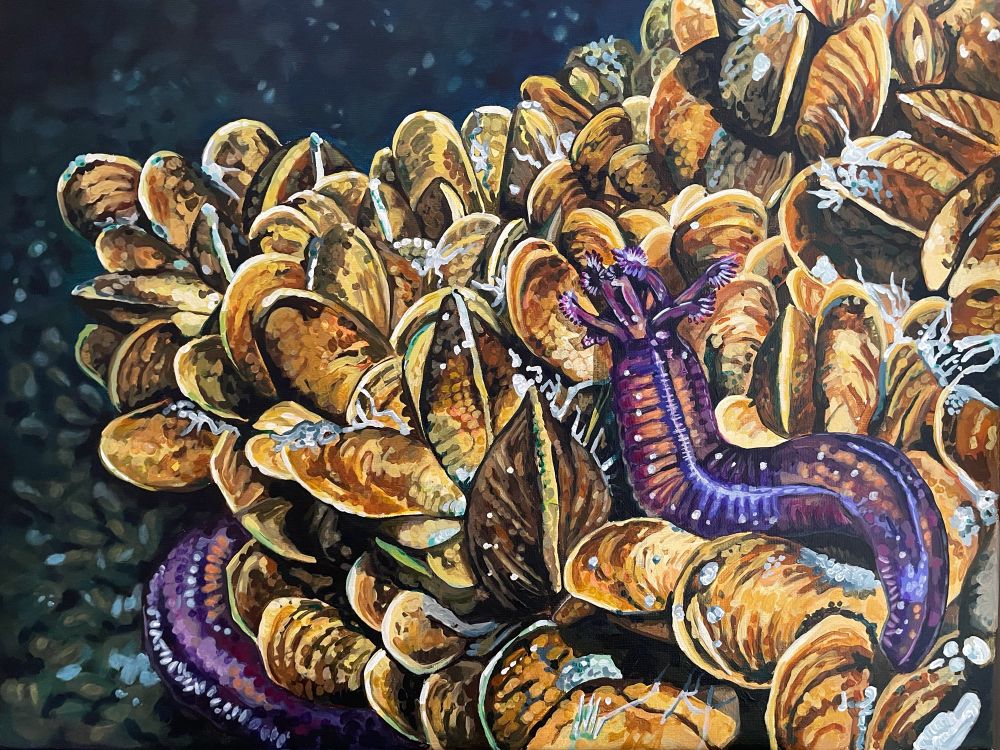
A bright purple sea cucumber swimming across golden brown mussels at a deep sea cold seep #SciArt #deepsea #deepseacreatures
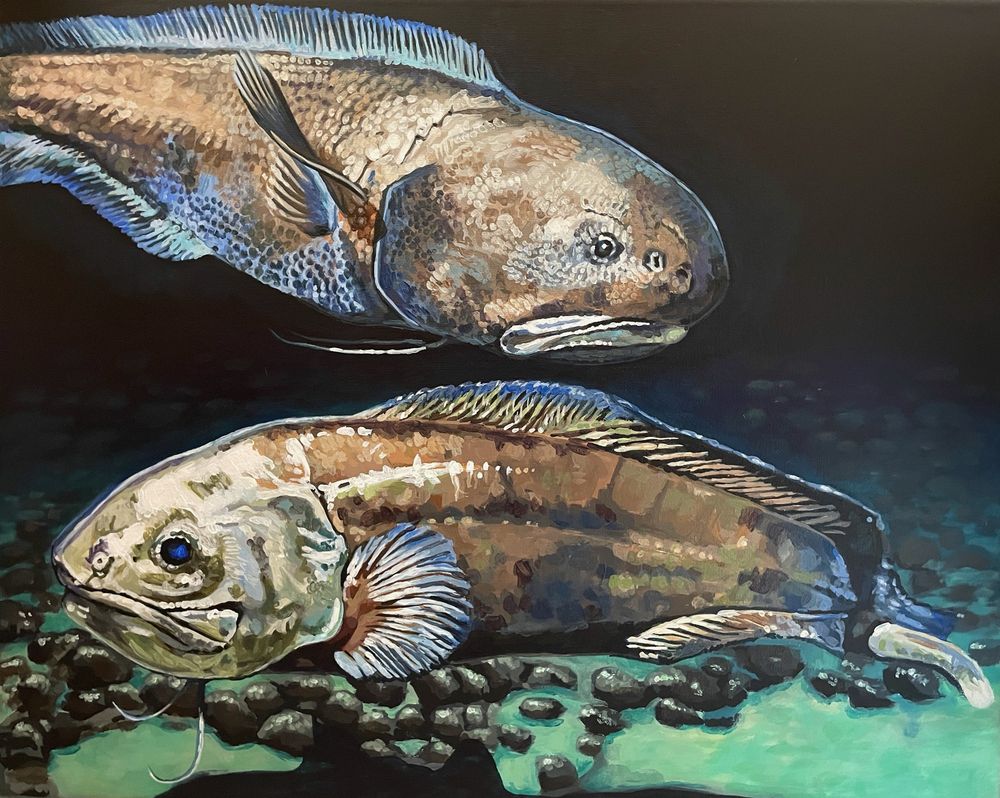
Two large brown, deep sea fish, bassozetus robustus and Spectrunculus grandis swimming over a sea bed covered in rocks #SciArt #deepsea #deepseacreatures
Hey! I’m Meghan, a lifelong artist; painter and drawer. The deep ocean has my heart and I adore painting unusual critters you don’t usually hear about ❤️ I’m contracted for writing and illustrating a deep ocean children’s book releasing in 2026. I also use deep ocean images in my personal work.
15.02.2025 16:16 — 👍 201 🔁 46 💬 8 📌 1
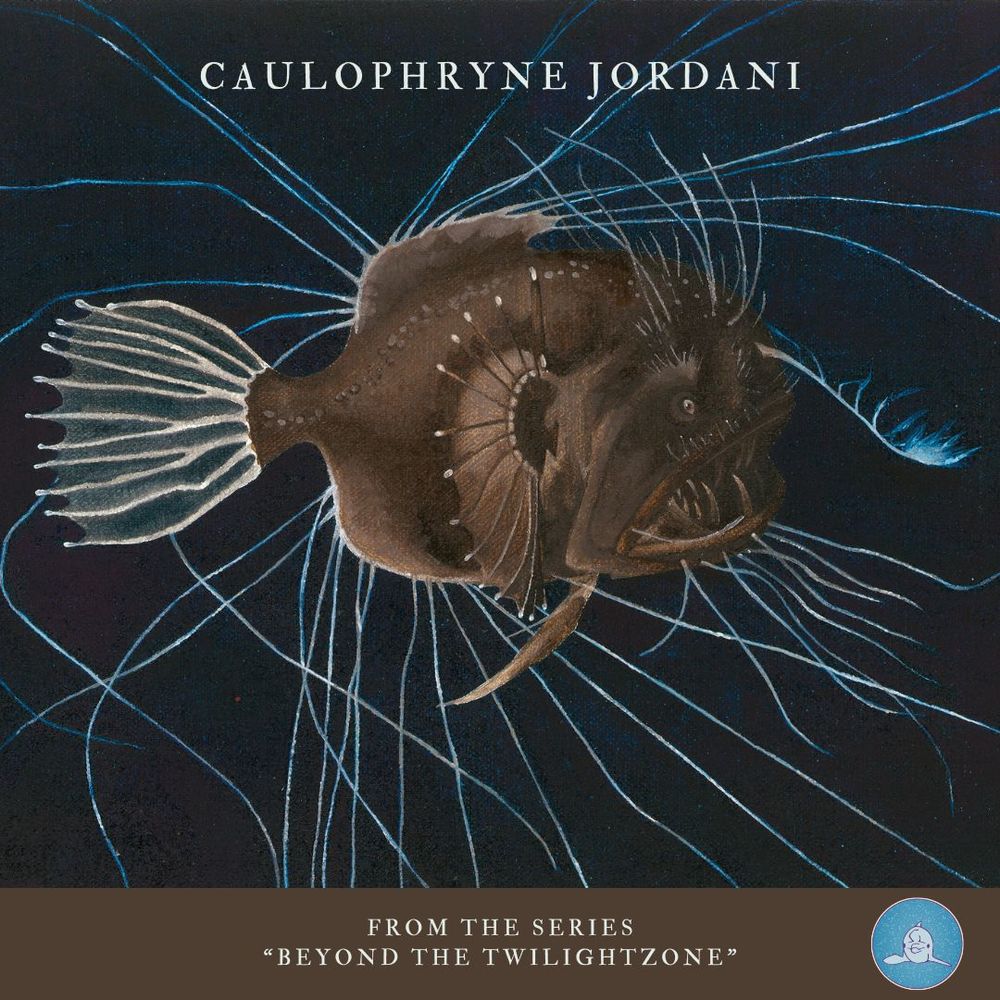
The anglerfish is a terrifying-looking fish with a large maw filled with sharp teeth. Her stomach is elastic, so she can swallow large prey in one go. She is dark brown to black, which makes her almost invisible in the dark all around. She is not very tall, barely 20cm, but long fin rays envelop her like a net of filaments. She also possesses a rod on her forehead with a whitish, luminous tassel. With these, she lures curious, unsuspecting animals to her mouth. She is not an active hunter. She swims slowly and weightlessly in the slow current, waiting for her meal.
I use the words "her" and "she" because this is what the female anglerfish look like.
The male, who usually does not grow larger than a few centimeters is also seen in the illustration: the measly little appendage on the belly of Ms. Anglerfish.
This is also part of the text that I wrote for my book Beyond the Twilightzone. It's more of a catalog of all my deep sea paintings. I dream to make it as a gorgeous artbook someday...
But for now, the catalog is for sale on Amazon: https://www.amazon.co.uk/Beyond-Twilightzone-Delphine-Mestdagh/dp/1916849776/ref=tmm_hrd_swatch_0?_encoding=UTF8&qid=&sr=
Happy #sundayfishsketch !!
This is my anglerfish I painted a couple of years ago...
Hope you like it 😊
Check out all my deep sea and microworld paintings on my website www.delphinemestdagh.be
Love to hear from you 💙
23.02.2025 08:41 — 👍 19 🔁 5 💬 0 📌 0
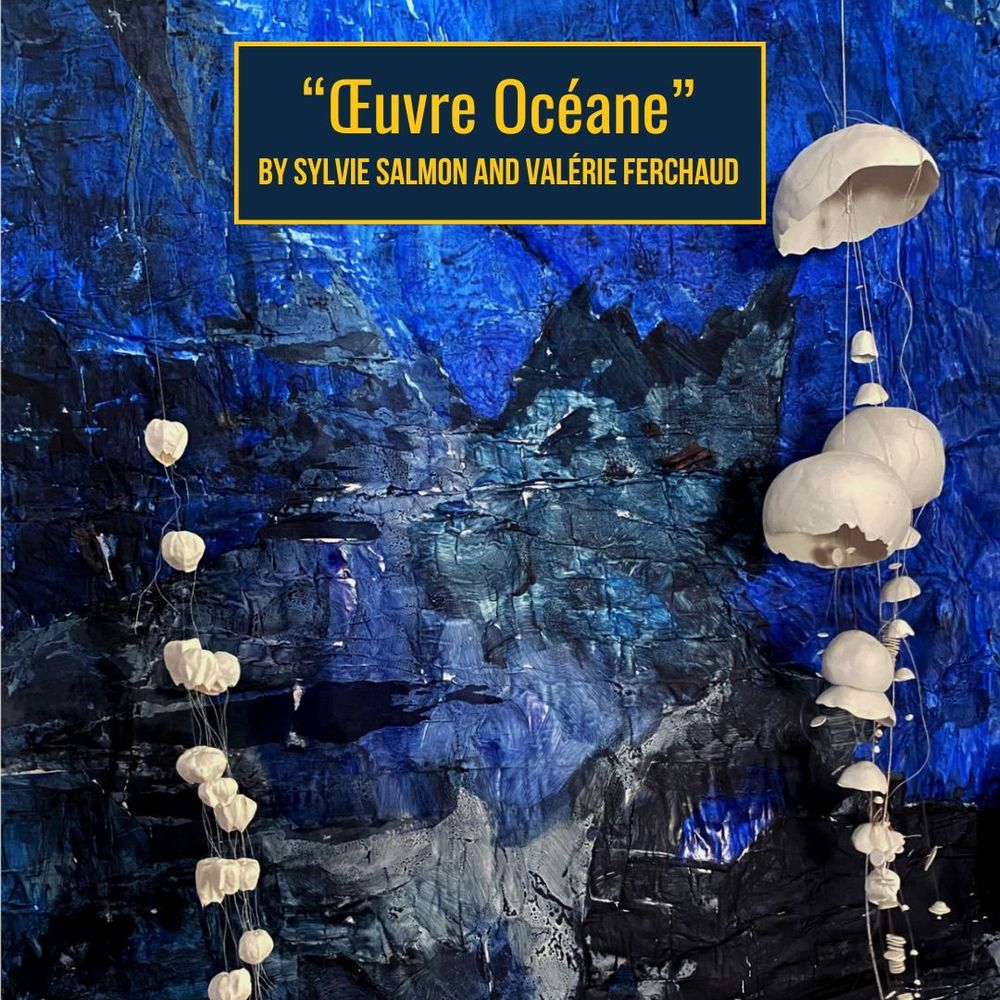
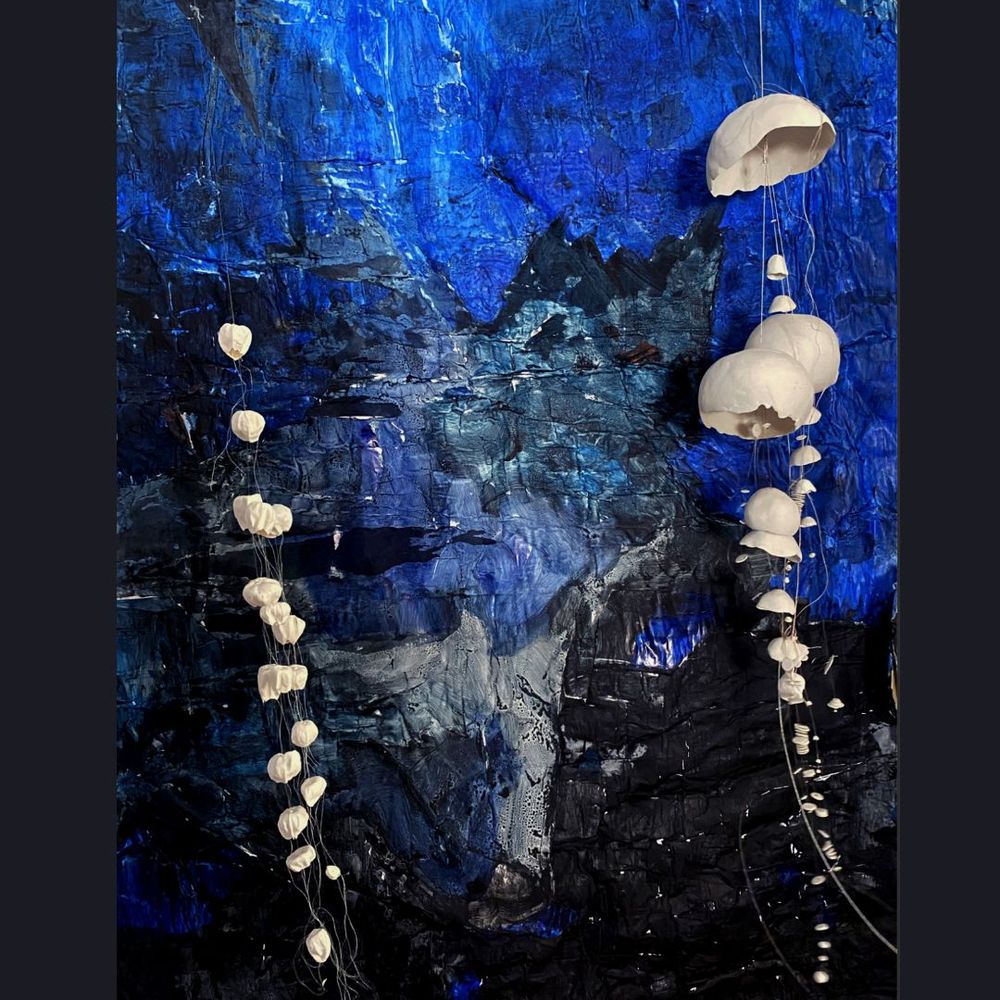
“Œuvre Océane” is an amazing collaboration between two DSBSoc-artists we introduced earlier: Sylvie Salmon and Valérie Ferchaud.
210 x 120 cm
Acrylic paint and ink on poster wall
by Sylvie Salmon
Porcelain
By Valérie Ferchaud
#sciart #porcelain #contemporary #deepsea #marinebiology #ceramist
22.02.2025 13:33 — 👍 11 🔁 2 💬 0 📌 0
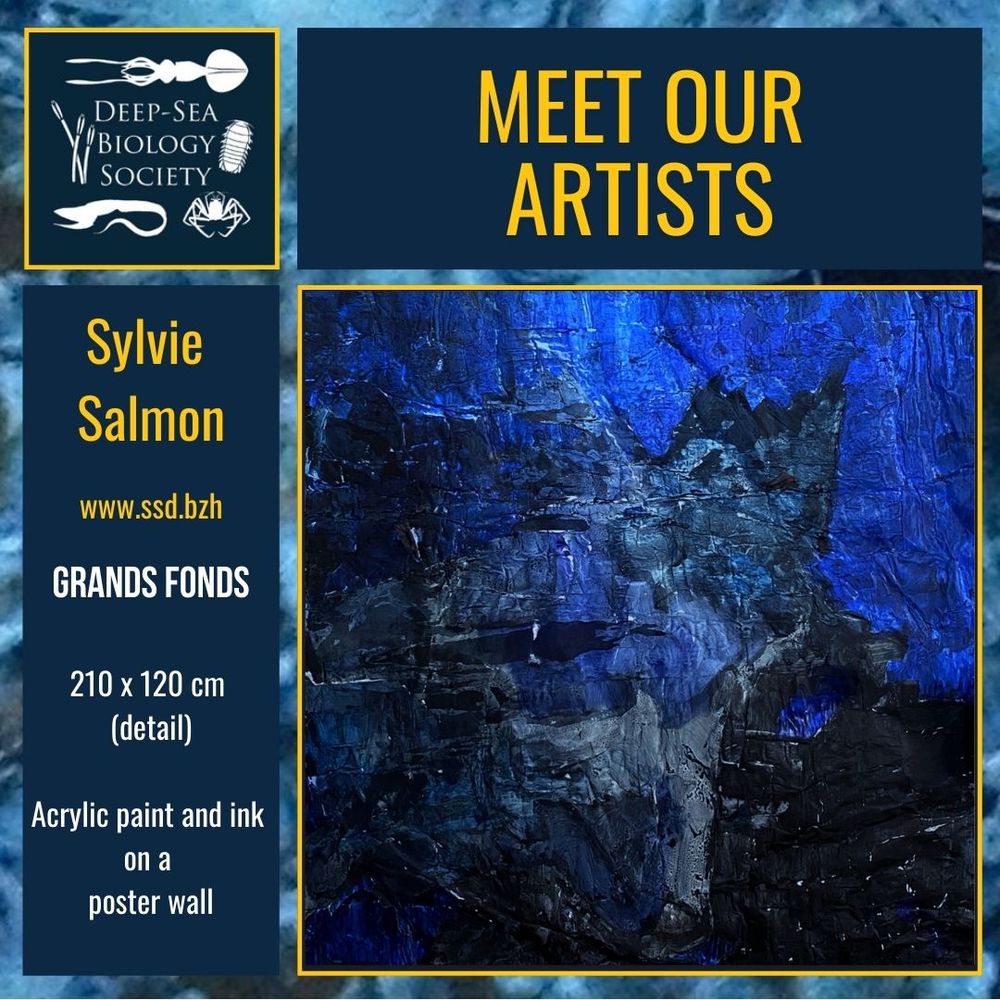
Artist statement:
“I am a graphic painter, graduate of Applied Arts in industry. Duperré School, in advertising design and graphic art.
At the exit of Arts Appliques. in 1973. I joined Aéroports de Paris and participated in the preparation of the launch of the new Roissy CDG airport in 1974. From 1981 to 2010, I assumed union responsibilities in transport, then in 1996 I returned to Aéroports de Paris and successively became in charge of commercial relations with Air France then Director of the Orly West Terminal.
From my multidisciplinary training in Applied Arts. I maintain an interest in all forms of creation. I continue to draw and paint as often as possible with the plan of being a painter later.
Since 2011, I have lived and worked in my workshop in Rennes. Later became now!
I work mainly on the theme of memory: the organization of human memory, books and their rhythm in libraries. ancient writings. architecture. major projects and beyond. the perpetual formation of Earth and Space.
My favorite media often had a first life.
I reuse large cardboard packaging boxes and already used papers. for example pleater rolls. poster walls.
I like to work on wrecked supports, if they are not wrecked from the start, I “wreck”” them up myself, notably by pleating in such a way as to make the graphic gesture more or less random.
I then carry out work of construction, deconstruction/reconstruction of the work by a process that I call tearing/pasting. I sometimes introduce covers. for example using red threads and hidden texts.
Moreover. I practice sketching with a felt-tip pen on the spot and as often as possible.”
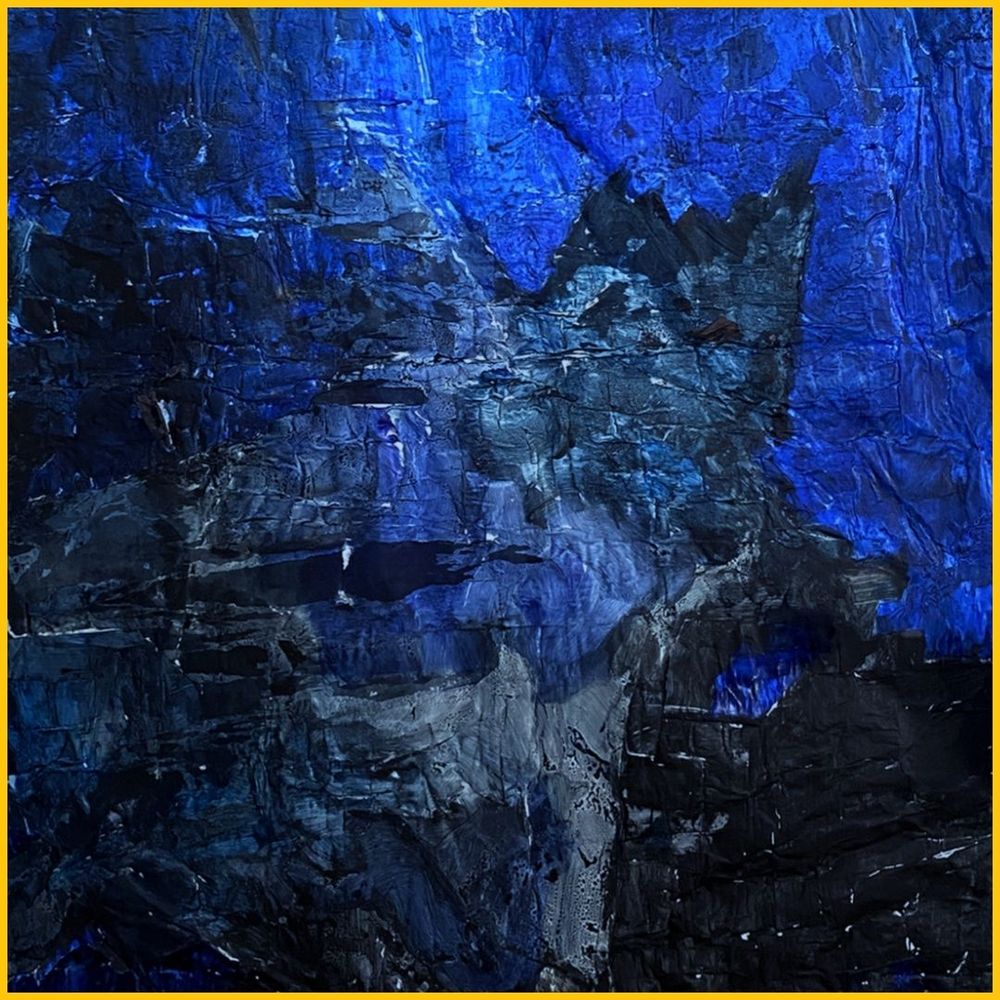
MEET OUR ARTISTS
Today:
Sylvie Salmon
www.ssd.bzh
There is more about the artist in the ALT-text 💙
Follow our main account @dsbsoc.bsky.social
#artandscience #sciart #sciartist #marinebiology #deepsea #deepseartist #contemporaryart #contemporaryartist #contemporarypainter #bridgingartandscience
17.02.2025 17:31 — 👍 7 🔁 3 💬 0 📌 0
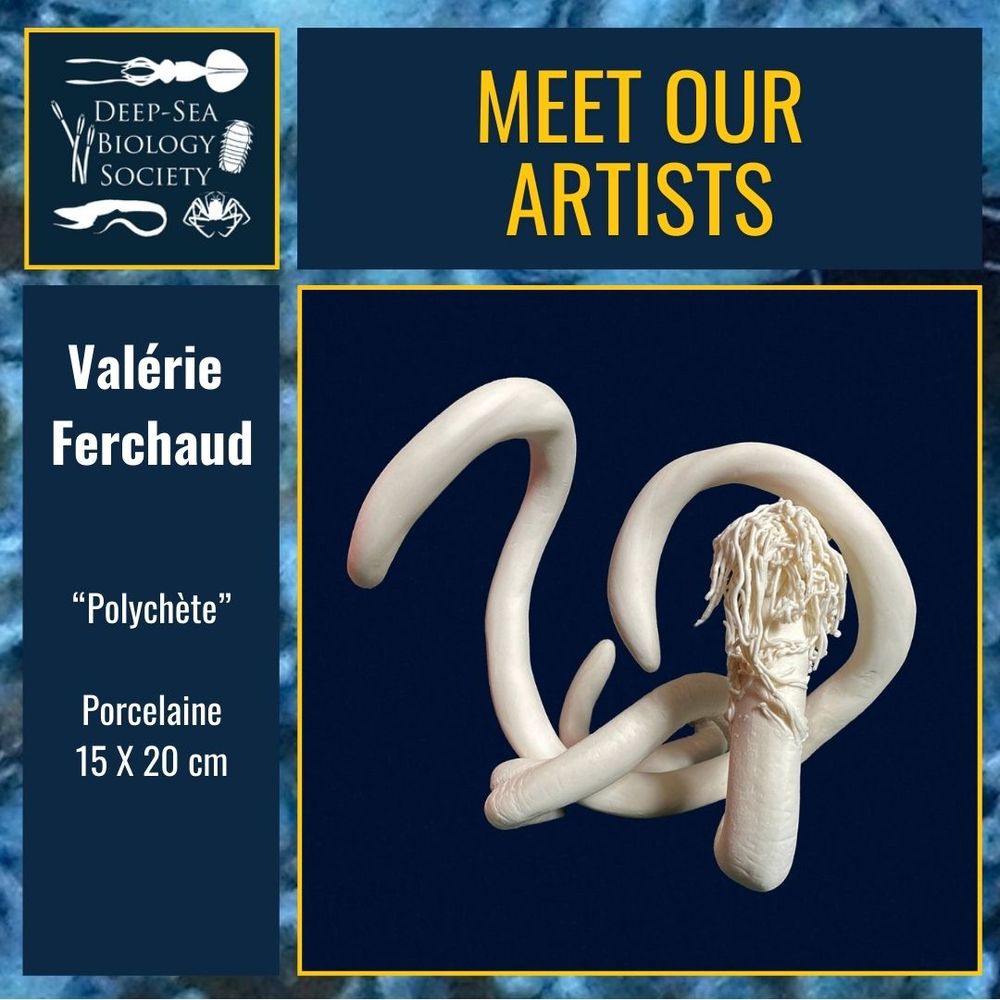
Presenting Valérie Ferchaud with a white, 15X20 cm ceramic Polychaete. A graceful way to present this enigmatic creature.
Artist statement:
“Attracted by the depth, I was able to continue experimenting with a creation using mixed techniques to try to express what I understood, learned from a dialogue that I found fruitful and unexpected with scientists. I wanted to share my vision. I had a lot to learn from the work of researchers in their understanding of the world of the abyss, so unknown to me and to most of the people around us. I think there's no better way than to listen to them, watch them work and, at the same time, see what my eye as a photographer and ceramist can see.... After several residencies in the Ifremer laboratories (BEEP - GEOCEAN) in 2022, I was able to digest the information and work on an exhibition entitled ‘The abyss, where life is invented’ as part of the Ressac 2024 festival (art & science) in collaboration with Sylvie Salmon (painter), which enabled us to capture what our eyes say about a world that is both dark and luminous. Together, we can aspire to express the poetry of a living world and of vast, ignored mountainous spaces, to discover and share the beauty of the oceans and our earth.
My interest in the abyss is leading me to create new works in the future, and I hope to meet other researchers and why not go on an expedition with them?”
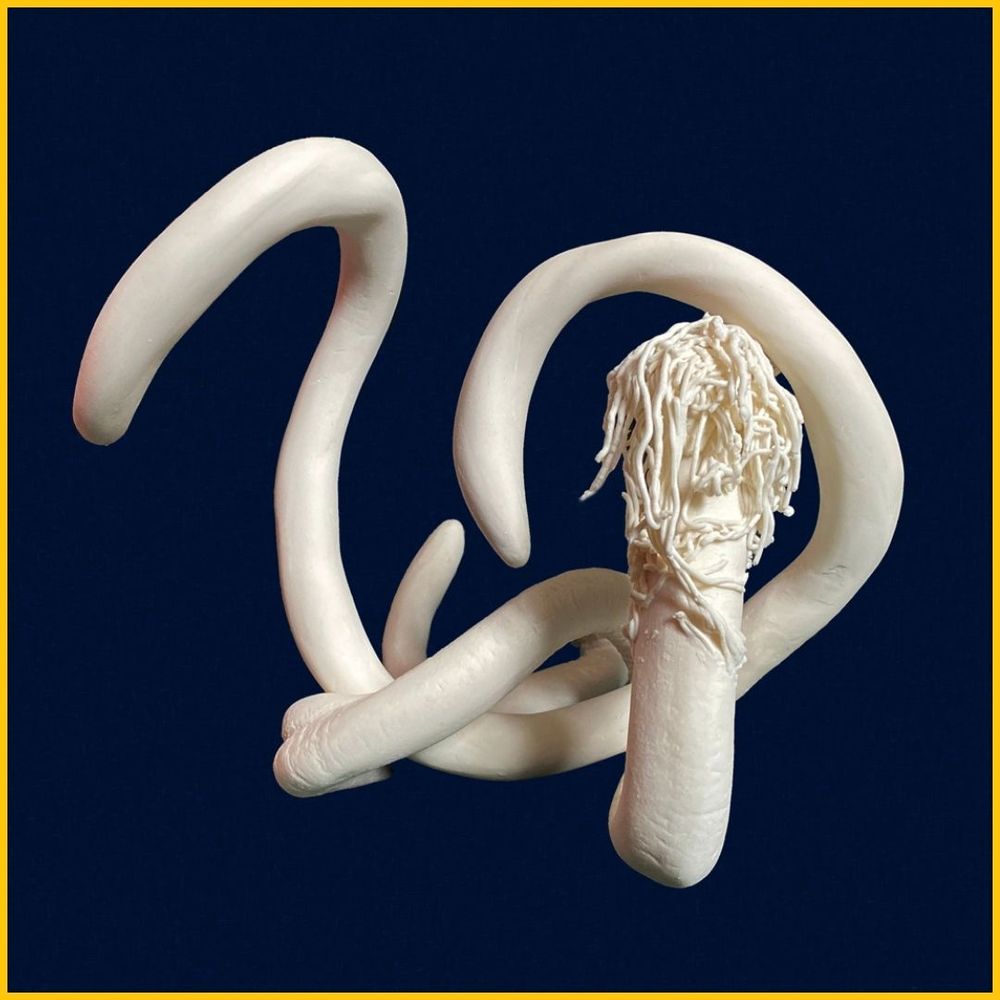
MEET OUR ARTISTS
Valérie Ferchaud
For more about Valérie, our DSBSoc-artists and all about deep sea- science, please visit
dsbsoc.org
and follow our main account @dsbsoc.bsky.social
#sciart #ceramics #contemporary #marinebiology #polychaete #worm #dsobsoc
(Artist statement in ALT-text)
13.02.2025 10:26 — 👍 13 🔁 4 💬 0 📌 0
Thank you so much 🙏🏻
09.02.2025 18:54 — 👍 1 🔁 0 💬 0 📌 0
The DSCC is campaigning to protect vulnerable deep-sea ecosystems & conserve deep-sea species. Follow us and take action to protect the incredible biodiversity of the sea.
deep-sea-conservation.org
An oceanographic research institute focused on advancing marine science and engineering to understand our changing ocean
She/her, BFA, lifelong artist, deep ocean obsessive, author/ illustrator, tell your dog I said hi ❤️
www.studiombj.com
My children’s non-fiction science book releases in June 2026- click link for book release mailing list 👆🏻
I lecture biology and research marine ecology & fisheries. I run. I travel. I strive to perceive concepts, ideas & animals. Views are my own (or I think). Reskeet=Read this.
📷 Top Landscape Photography
©️ Only Attributed Works
✔️ Verified No AI
Collaboration: editorial@landscapehead.com
British Palaeobotanist, palaeobotanical illustrator and consultant, currently researching Mesozoic plants.
🌿Commissions and consulting open!🌿
BSc, MRes
(she/her)🏳️⚧️🏳️🌈
patreon.com/JulianneKiely
https://palaeoflora.blogspot.com/
I make movies. I watch movies. I love movies.
Trying to write two connected series (fantasy) in the world I’m building. Creating glass art (and attempting to draw) when not writing.
Lover of insects & arachnids, snakes & all weird sealife.
EastCoastKin
My soul belongs to the sea.
Chicago-based paleoartist. He/him. Email for commissions/inquiries at liam_elward@yahoo.com
Brooklyn-based graphic designer. Love #music #art #design #ceramics LGBTQ+ Ally
The best collection of art paintings and drawings on Bluesky, credits to all participating artists! (no sales, NFT's etc.)
"𝐋𝐨𝐯𝐞 🦁𝐭𝐡𝐞 𝐚𝐧𝐢𝐦𝐚𝐥𝐬 𝐚𝐧𝐝 🌴𝐖𝐢𝐥𝐝𝐥𝐢𝐟𝐞 𝐛𝐞𝐜𝐚𝐮𝐬𝐞 𝐭𝐡𝐞𝐲 𝐚𝐫𝐞 𝐭𝐡𝐞 𝐭𝐫𝐮𝐞 𝐆𝐨𝐥𝐝"
I draw cute monsters and landscapes || Cozy Spooky Vibes || It's always Autumn here 🎃 ||
Layout/BG Artist and Storytelling Illustrator~
Check out my art feed or #art for art ONLY! (✿◡‿◡)
Other socials! >>>
https://melotea.carrd.co/
Canadian freelance artist — Board Games // Currency // Prints
No A/I or NFT
Prints and other socials here: https://linkpop.com/smeesh
🇸🇹🇦🇸
🦄 Fantasy & Wildlife Artist
🍁 BC, Canada
🌿 She/Her
🚫 NO AI/NFT 🚫
Official Website www.stasanie.com
Official Server https://discord.gg/skullery
Artist/writer of ARC29, soft slice of life sci fi comic and one half of HΩME, a shared universe series with my offline brother.
Long-form, serialized comics for discerning readers.
homecomics.ca
he/him
I draw stuff & repost art I like! Main account @charlenedraws.bsky.social
Portfolio: sygnin.com
Commission info: https://sygnin-comms.carrd.co/
🚫 AI /NFT
Eldritch Millennial, Traditional Fine Artist and Illustrator
Specializes in Dark Fantasy, Horror and Nature themes #art
🚫AI/NFTs 🚫AI
For commercial work:
illustration@christie-adams.com
Other places you can find me:
https://bio.site/CAdamsArt
✦Digital & Traditional Artist ✦ Graphic Designer ✦Emote Artist ✦ ♎✦ INFJ-T ✦ She / Her ✦ Canadian ✦ Twitch Streamer ✦ peppermint.on.twitch@gmail.com✦ 🚫 NO AI
http://yay-peppermint.com
#art
Artist in progress. Living on Treaty 6 land. Art, science, space & politics (sorry about that) Dad to Samwise. Storms & stuff. He/him. No AI, No NFT. https://earthskyart.ca #art #painting #sciart #fod #biking


























![Presenting another DSBSoc-artist named Véronique Robigou with her painting "Deep Sea Oasis"
Véronique wrote about this artpiece:
"As a marine geologist, I mapped unexplored territories of seafloor and underwater volcanoes with deep submergence vehicle including DSV Alvin. And decades later, vivid, retinal vestiges of ocean landscapes that I explored still inspire my artwork. Deep Sea Oasis is my impression of a fairy castle, hot spring that rises from the inky black, basaltic ocean floor. On a dive with chief scientist J. R. Delaney, and Alvin pilot D. Foster we discovered the High-Rise hydrothermal vent field on July 17, 1991. It lies on the northern segment of the Juan de Fuca Ridge which is a spreading center off the coasts of Oregon, Washington, and British Columbia. The Pacific and North American tectonic plates are born at and spread away from this volcanic ridge. Subsequent mapping in September 1991 unveiled spectacular, geyser-like towers gushing unusually large, rising plumes of metal-laden, hot water. These sulfide-rich, mineral edifices are called hydrothermal vents and spew fluids at temperatures up to 400°C [752 °F] through chimneys and upside-down cascading flanges."
More about "Deep Sea Oasis" in the next ALT-text](https://cdn.bsky.app/img/feed_thumbnail/plain/did:plc:7ql4q76gbznue7dsi6nrsegu/bafkreiaxb2cjgvuzi6qcmv22mdgy7sywjhwgaebfsnlg77rwl73ec66jhy@jpeg)


